- Types of Sailboats
- Parts of a Sailboat
- Cruising Boats
- Small Sailboats
- Design Basics
- Sailboats under 30'
- Sailboats 30'-35
- Sailboats 35'-40'
- Sailboats 40'-45'
- Sailboats 45'-50'
- Sailboats 50'-55'
- Sailboats over 55'
- Masts & Spars
- Knots, Bends & Hitches
- The 12v Energy Equation
- Electronics & Instrumentation
- Build Your Own Boat
- Buying a Used Boat
- Choosing Accessories
- Living on a Boat
- Cruising Offshore
- Sailing in the Caribbean
- Anchoring Skills
- Sailing Authors & Their Writings
- Mary's Journal
- Nautical Terms
- Cruising Sailboats for Sale
- List your Boat for Sale Here!
- Used Sailing Equipment for Sale
- Sell Your Unwanted Gear
- Sailing eBooks: Download them here!
- Your Sailboats
- Your Sailing Stories
- Your Fishing Stories
- Advertising
- What's New?
- Chartering a Sailboat
- 12v Demands

Boat Electrics: The Demands of the Domestic System
The subject of boat electrics is a complex one, but the bottom line is that the current draw, battery bank capacity and charging regime must all be matched for the 12volt system to function satisfactorily.
Here we deal with the first part of that equation; calculating the current draw of your of the domestic circuit of the boat electrics over a typical 24 hour period.
Once this is known it's straightforward to assess the required size of the domestic battery bank.
And with that knowledge we can readily calculate the battery charging regime necessary to prevent undue strain on the batteries and keep the whole electrical system ticking over.
Boat Electrics ~ Assessing the Daily Current Draw
To calculate our daily domestic electrical requirement we must first make a list of all electrical equipment on board, and apply a current rating to each item.

If you've got a battery monitor installed in the system and capable of being switched to read amps - like the one shown here - you'll be able, by turning on one item at a time, to read the actual current draw for each item - otherwise you'll have to use a multimeter, or work it out.
Ratings can usually be found on equipment nameplates or in their manuals, and will be expressed in terms of power (measured in watts) or current draw (measured in amps). The relationship between power and current is expressed as: Power (W) = Current (A) x System Voltage (V) To derive amps from watts, simply transpose this equation and divide the wattage by the system voltage.
For example, a 6 watt navigation light bulb in a 12 volt system will draw 0.5 amps - which, if it's switched for ten hour each day when underway will have consumed 5 amp-hours (Ah).
Continuing in this vein for each item of equipment will produce a table much like that shown below, which incidentally, is the one I did for my boat Alacazam.

This calculation though, remains an estimate. For example:
- in cold weather the fridge will draw less power than in hot weather;
- in rough weather the autopilot would use more power than when it's calm;
- hours of darkness will vary with latitude and time of year, affecting current draw for navigation and domestic lighting;
- you'll use the watermaker more when you've got guests aboard etc, etc;
- plus there are start-up currents and other losses that have been ignored.
So it's approximate, but indicates that you'll need to replace around 325Ah each day when you're sailing and 211Ah when you're at anchor.
The underway current consumption clearly presents the worst case scenario, with more power being consumed during the night than during the day. In this example the domestic battery bank will be drawn down by 175Ah during the hour night-time hours - an average discharge of around 14.6A over 12 hours.
So what's the difference between amps (A) and amp-hours (Ah)?
The best way to explain it is by example...
If an appliance drawing 5A was to run for 1 hour, its consumption would amount to 5Ah.
This would be the same as an appliance drawing 1A running for 5 hours - again the consumption would be 5Ah.
So amp-hours are simply the (average) amperage drawn multiplied by the time in hours.
Boat Electrics ~ Power Conservation
In our example there're several things that could be done to reduce the daily consumption:
- LED (light emitting diode) lights. These draw a fraction of the current taken by a standard incandescent light and have an exceptionally long service life. I reckon if the anchor light, tricolour, cockpit light and cabin lights were replaced with LED's then at least 15amps could be shaved off the underway consumption and a similar amount off when at anchor. A further benefit of a combined anchor/tricolour LED light is that you won't have to scoot up the mast to change a blown bulb - a prospect I view with increasing dismay these days.
- The autopilot. If you had windvane self-steering it wouldn't use any power at all, reducing the daily drawdown by a whopping 31%.
- The freshwater pump. Turn it off on passage and use the hand pumps.
You might like to take a look at these...

Understanding Boat Batteries and Onboard Electrics
Sizing your boat batteries to match your 12 volt electrical requirement is only half the story; you need to align your charging capability too. Here's how to get everything right

Will a Marine Solar Panel Make Much Difference to Battery Charging?
Fitting a marine solar panel isn't always the most cost effective 'green energy' method of charging your boat's batteries. If you're thinking of fitting them you should read this first
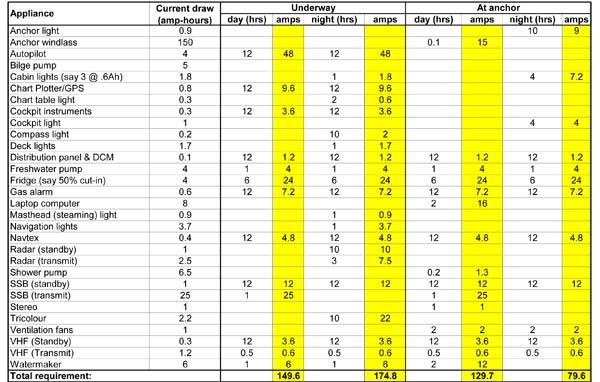
Controlled Marine Battery Charging for Reliable Onboard Electrics
Here's how to ensure that your marine battery charging regime properly matches the capacity of your boat's battery banks and keeps pace with the daily current draw down.
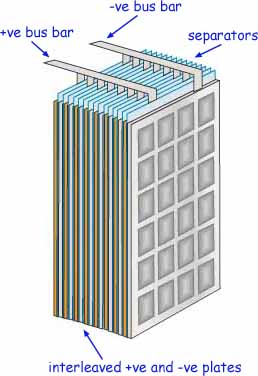
Which Deep Cycle Marine Battery Best Fits Your 12V Power Requirement?
A Deep Cycle Marine Battery is definitely the way to go, but which type is best? A liquid lead acid boat battery or one of the Valve-Regulated Lead Acid (VRLA) types? Find out here!
Daily Current Draw Calculator
Calculate your Amperage Requirement with this Daily Current Draw Calculator and use this information in selecting the Appropriate Battery for your Boat
Recent Articles
Wauquiez Gladiateur 33 for Sale
Apr 10, 24 05:40 AM
'Cabo Frio', a Catalina Morgan 43 for sale
Apr 01, 24 08:35 AM
Live Aboard Boats For Sale
Mar 30, 24 07:02 PM
Here's where to:
- Find Used Sailboats for Sale...
- Find Used Sailing Gear for Sale...
- List your Sailboat for Sale...
- List your Used Sailing Gear...
Our eBooks...

A few of our Most Popular Pages...

Copyright © 2024 Dick McClary Sailboat-Cruising.com
Simple Guide for Calculating Your Sailboat’s Energy Budget
A helpful approach to calculating your solar and battery systems for your sailboat or RV.
- Post author By Ryan
- Post date December 22, 2020
- 3 Comments on Simple Guide for Calculating Your Sailboat’s Energy Budget
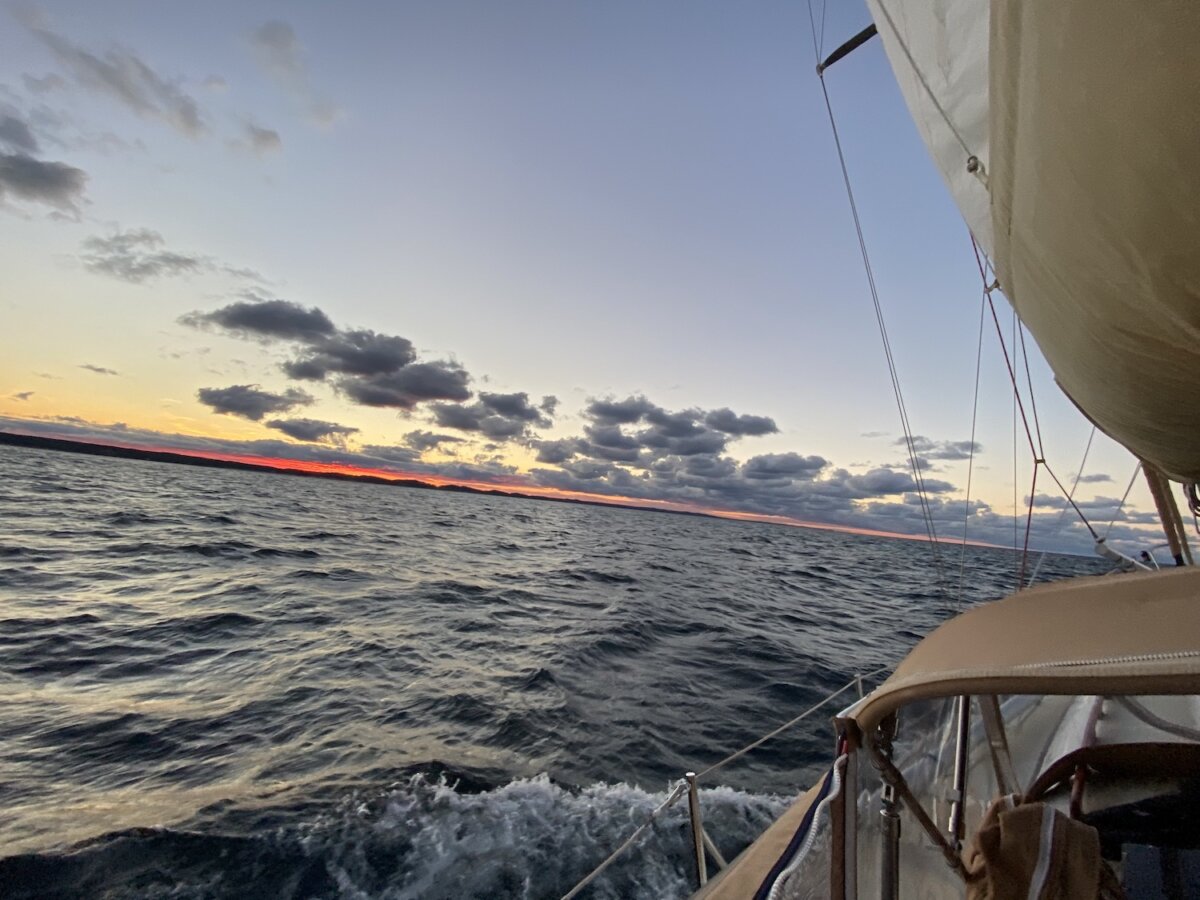
After spending way too much time figuring out how to size the power system for our boat, I thought it would be good to create a simple guide to estimating your needs. It is an excel file you can download/modify with your own sailing or RV needs. I ran through this math with our teardrop trailer, and now with the more complicated sailboat. This whole file is set up for a 12-volt system, you may need to make some modifications to this file for different voltages.
Start at the top of the document and fill out the yellow boxes. The file The results will show up at the bottom.
Energy Calculator
Think of your system as the combination of three different calculations:
- Energy generation from solar, wind turbine, generator, and/or alternator
- Energy storage to/from the battery bank
- Energy draw to the system demands
Each system needs to be sized appropriately for your application, which starts with the demand you expect to have in your system. Start by listing all of the loads that will be on your system, and classify them in different ways: on anchor vs. on passage and define the minimum critical requirements. Then figure out how many amps and how many hours each draw will take on a given day – either on passage or at anchor. For example, we don’t need to run our autopilot while at anchor, and it’s one of the biggest amp draws we have on our boat.
Once you understand your overall system needs, you can play with sizing your solar panels and battery bank. This is the generation side of the equation. You want to make sure you’re accounting for usable sunlight, clouds, and a safety factor when making your assumptions. You also want to make sure you’ve got the ability to weather a few days of low (or zero) power generation. This all gets calculated at the bottom of the excel file where it shows the final calculations of how long you’d be able to last (theoretically) in each scenario, and what your excess/deficit would be.
What do you think? I’d love to get some feedback on the file/calculations.
- Tags amp draw sailboat , autopilot , Battle Born Batteries , Battle born lithium sailboat , current draw sailing autopilot , energy demands sailboat , sailboat energy budget , sailboat power calculator , sailboat solar , Sailing , sailing current draw , sizing battery bank sailboat , Sizing solar boat , solar power calculator , solar powered sailboat
3 replies on “Simple Guide for Calculating Your Sailboat’s Energy Budget”
Hey guys , lovely to read your blog regarding your ericson. I too own a 39b here in New Zealand and slowly going through a Refit. My understanding is only 19 to 20 of these were built. yours looks in great condition. regards Kyle
Thanks for the comment! Great to hear about other 39B’s out there! Overall it is in great condition, however we do have some wet spots we’re currently re-coring in the cockpit & foredeck. We’d like to hear more about your refit – we’re pretty active on Instagram @gerbersunderway if you want to message us there
Only just noticed your reply, sorry we don’t have Instagram but will try looking you up. regards Kyle
Leave a Reply Cancel reply
Your email address will not be published. Required fields are marked *
Save my name, email, and website in this browser for the next time I comment.
Search form
Onboard electricity basics & faq.
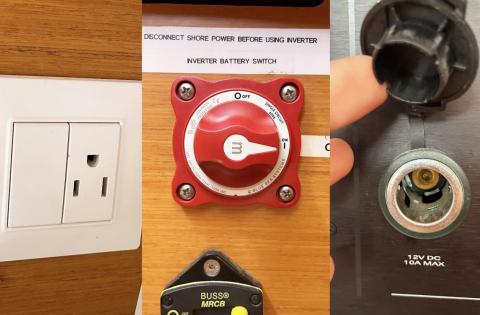
Want to keep your mobile devices charged or use a small appliance away from shore? If your bareboat charter plans include being away from the dock for more than a few hours, beforehand, it's a good idea to understand your boat's electrical system and how to properly utiitize it.
MSC boats are equipped with two types of electrical power systems onboard.
1) The 12 volt DC system is electrical current supplied directly from the house batteries (direct current = DC).
- Critical onboard systems such as navigation lights, cabin lights, and bilge pumps are wired to the 12 volt DC system.
- You can access 12v DC power through the round “cigarette lighter” outlets, which are often located near the chart table.
- 12v USB charging ports can also be found on some MSC boats, typically in the Gold, Platinum, and Catamaran Fleets.
12v Outlet on SV Attitude Adjustment.jpg
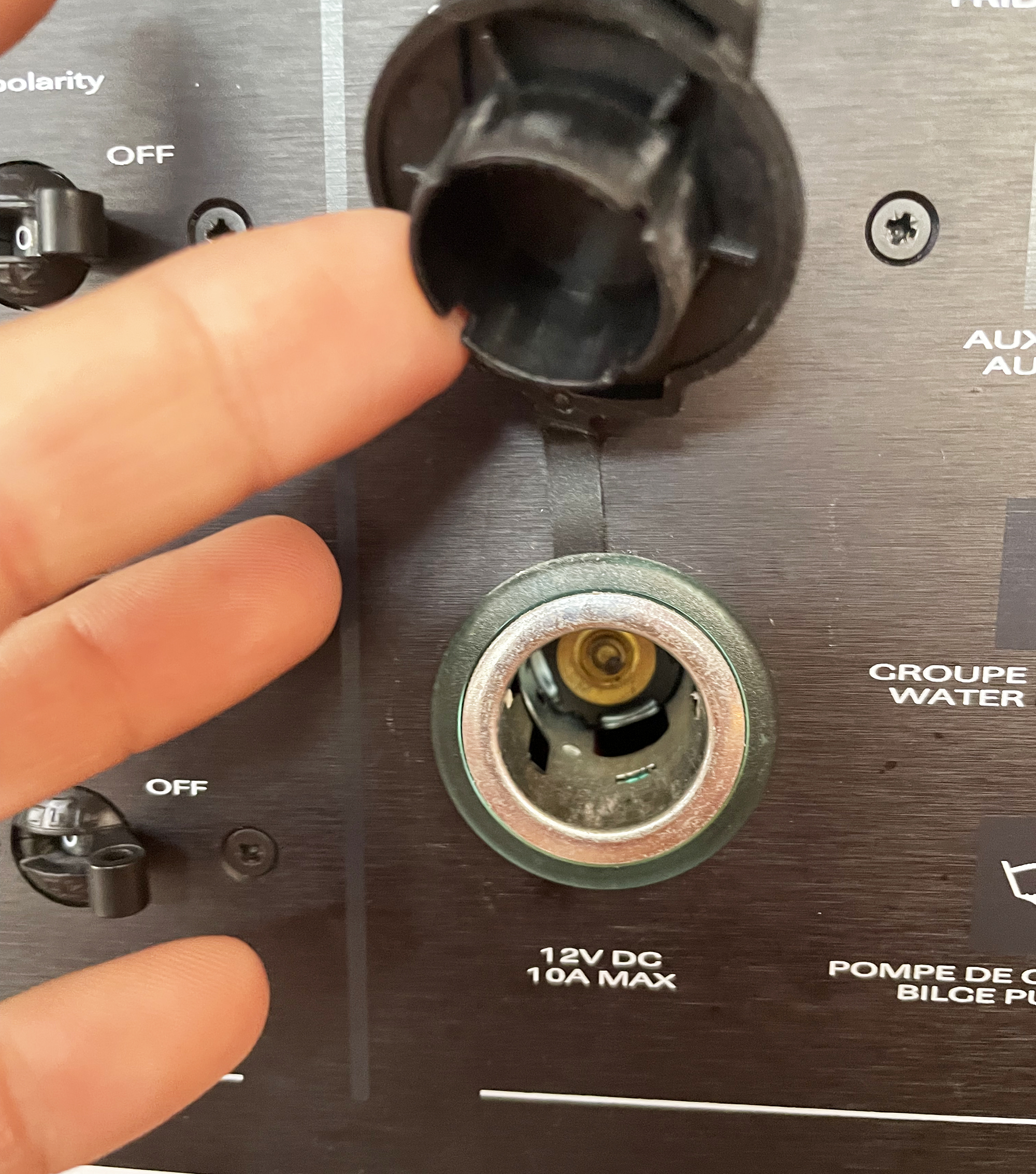
12v USB outlet.jpg
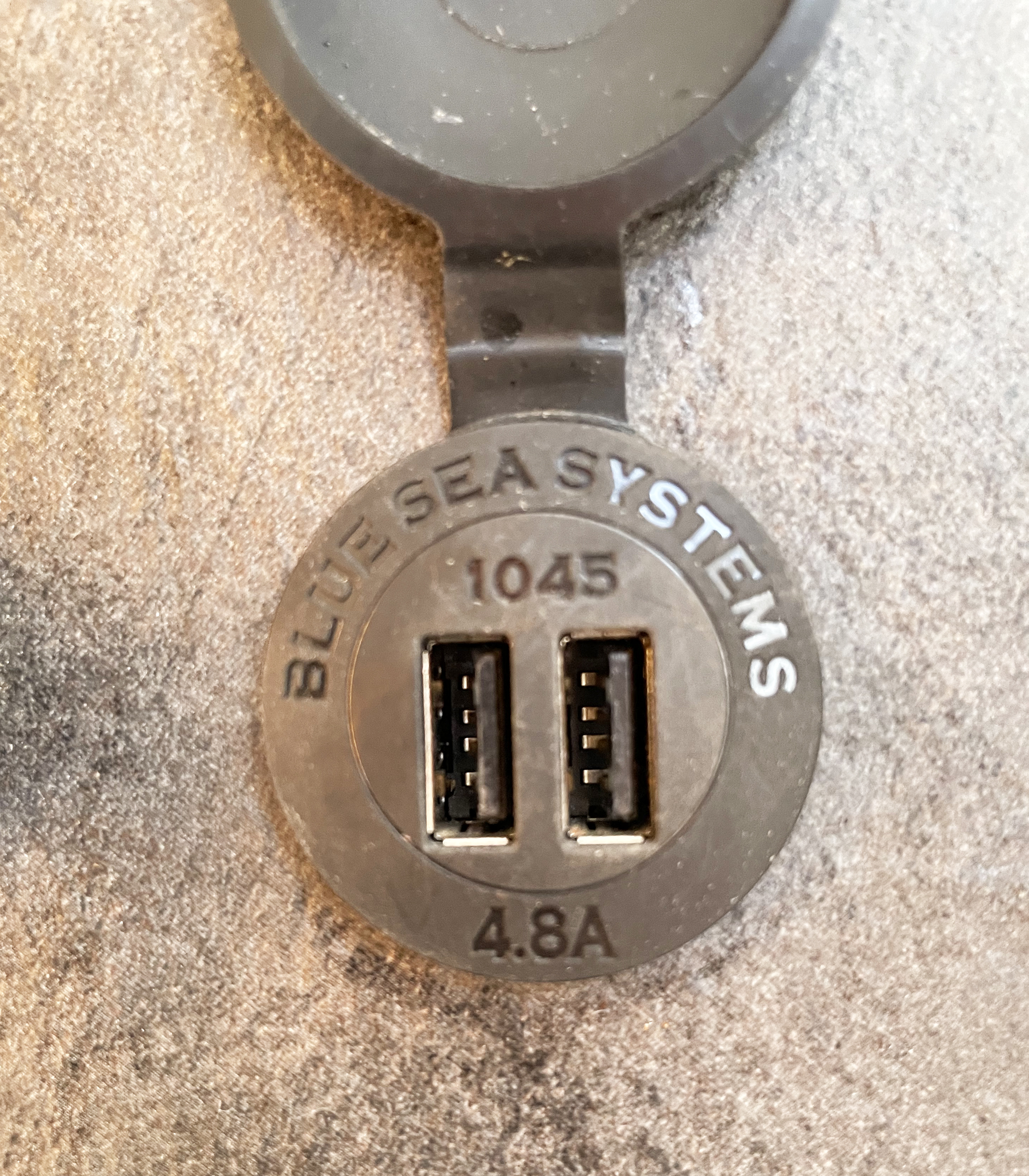
2) The 110 or 120 volt AC system is alternating current that comes from a connection to shore power or from an onboard power inverter.
- Inverters draw 12v DC electricity from the house batteries and convert it to alternating current. This enables the electrical system to power small electronics and appliances such as laptops and coffee makers.
- Connect to the 110 or 120v AC system via the standard house electrical outlets.
- Not all MSC boats come equipped with an inverter. Depending on the inverter, there are limits on how many watts of power an inverter can supply.
Standard 110v Outlet on SV.jpg
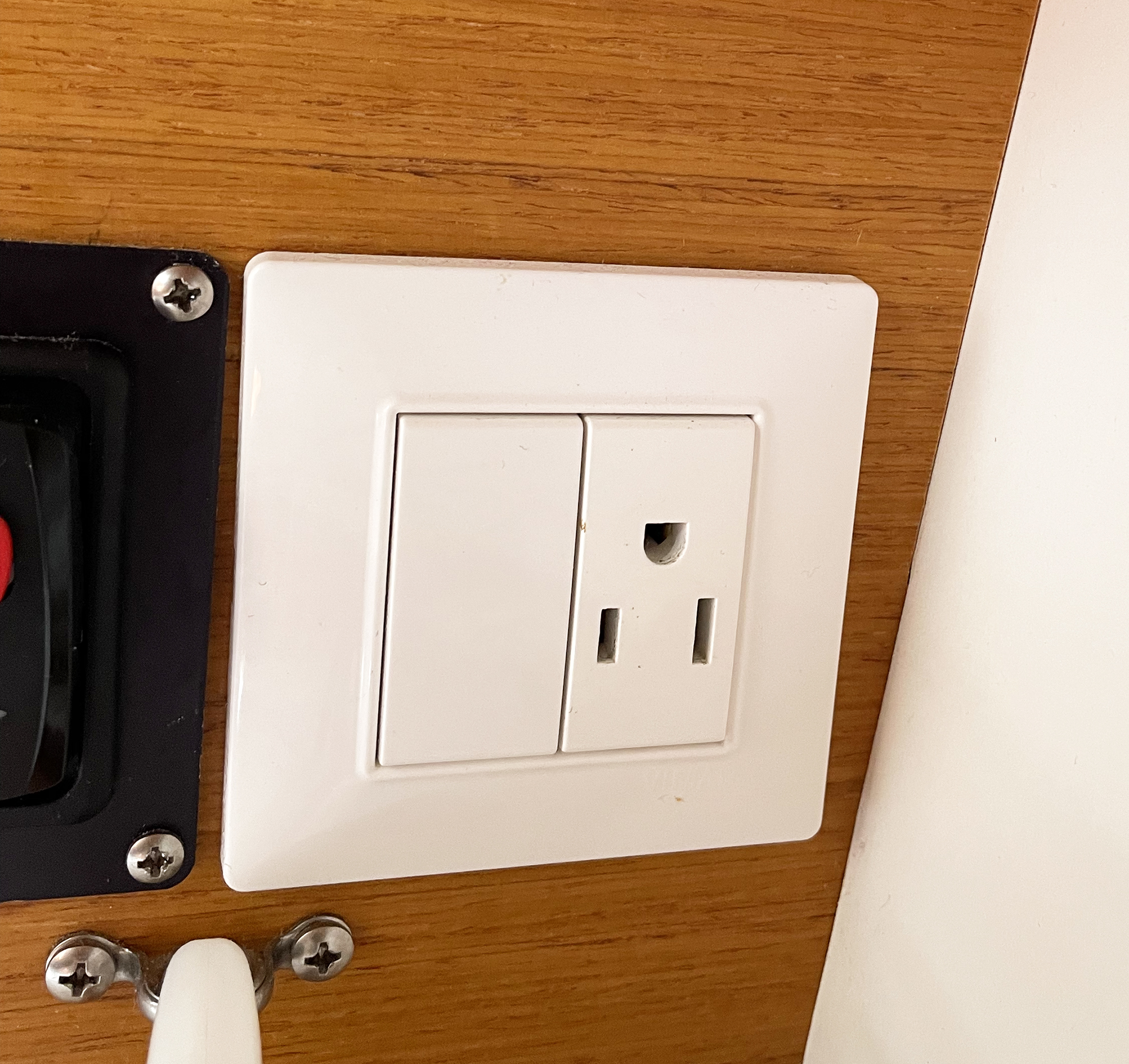
110 and 12v Outlets on SV Attitude Adjustment.jpg
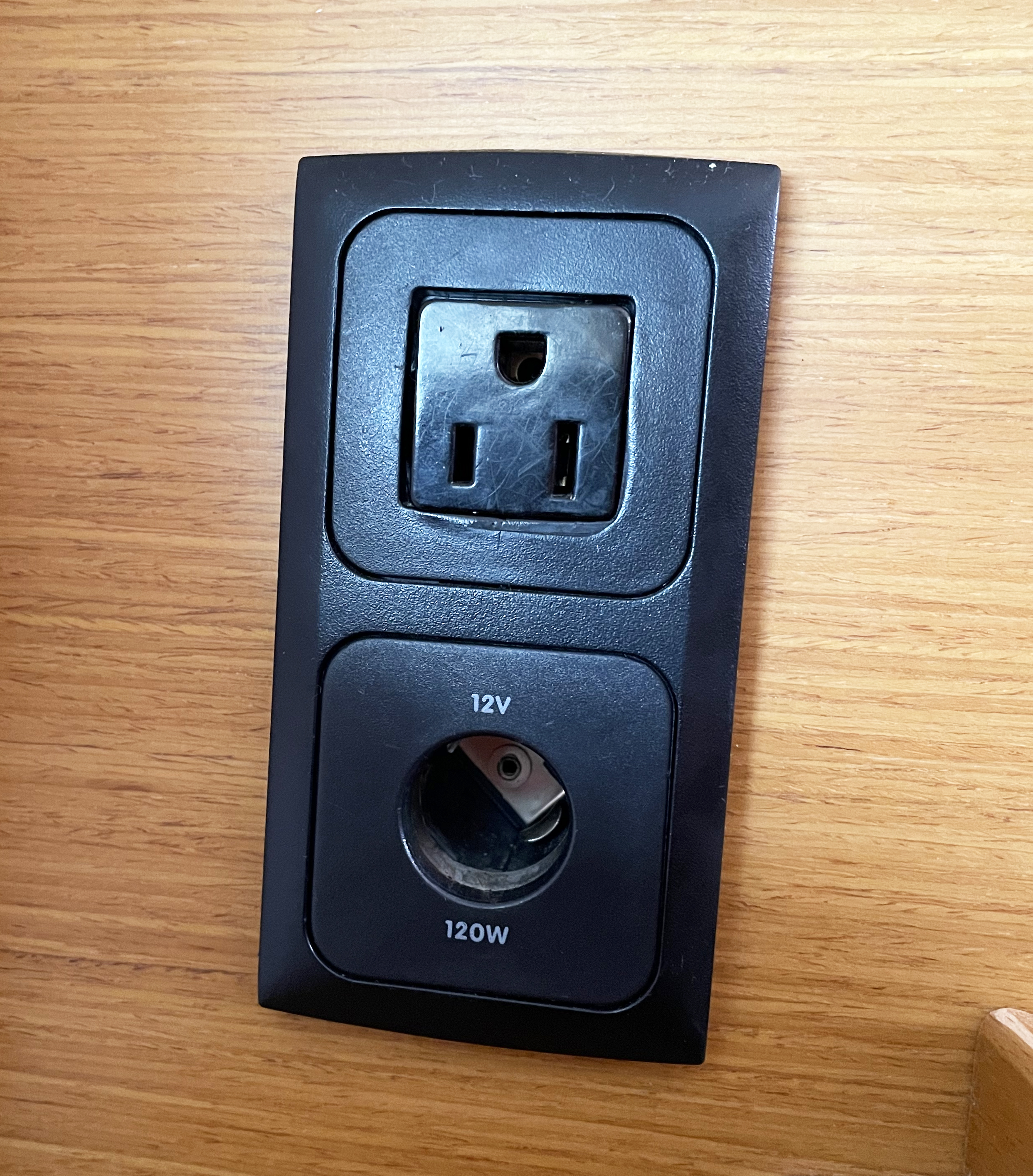
Below, we've compiled a list of common questions we've encountered from bareboat newcomers.
How do I use the inverter on my boat?
- Disconnect from shore power, if connected.
- Locate the AC system selector switch, if your boat has one, and ensure it's switched on.
- Locate the inverter's power switch to turn it on. In some cases, the power switch will be on the main electrical control panel. Some inverters have their own power switch built into them.
- If in doubt as to the location of switches, check the boat's white binder or ask an MSC fleet technician for assistance.
- Be sure to power off the inverter when the house outlets are not in use. The inverter will draw power from the batteries even when there is nothing plugged into the outlets.
- Use caution when operating small appliances to avoid draining the batteries or overloading the inverter. Any device that draws more than 800 watts is likely to overload and possibly damage the system. High wattage appliances such as hair dryers and microwaves cannot be used away from shore power.
Inverter Switch.jpg
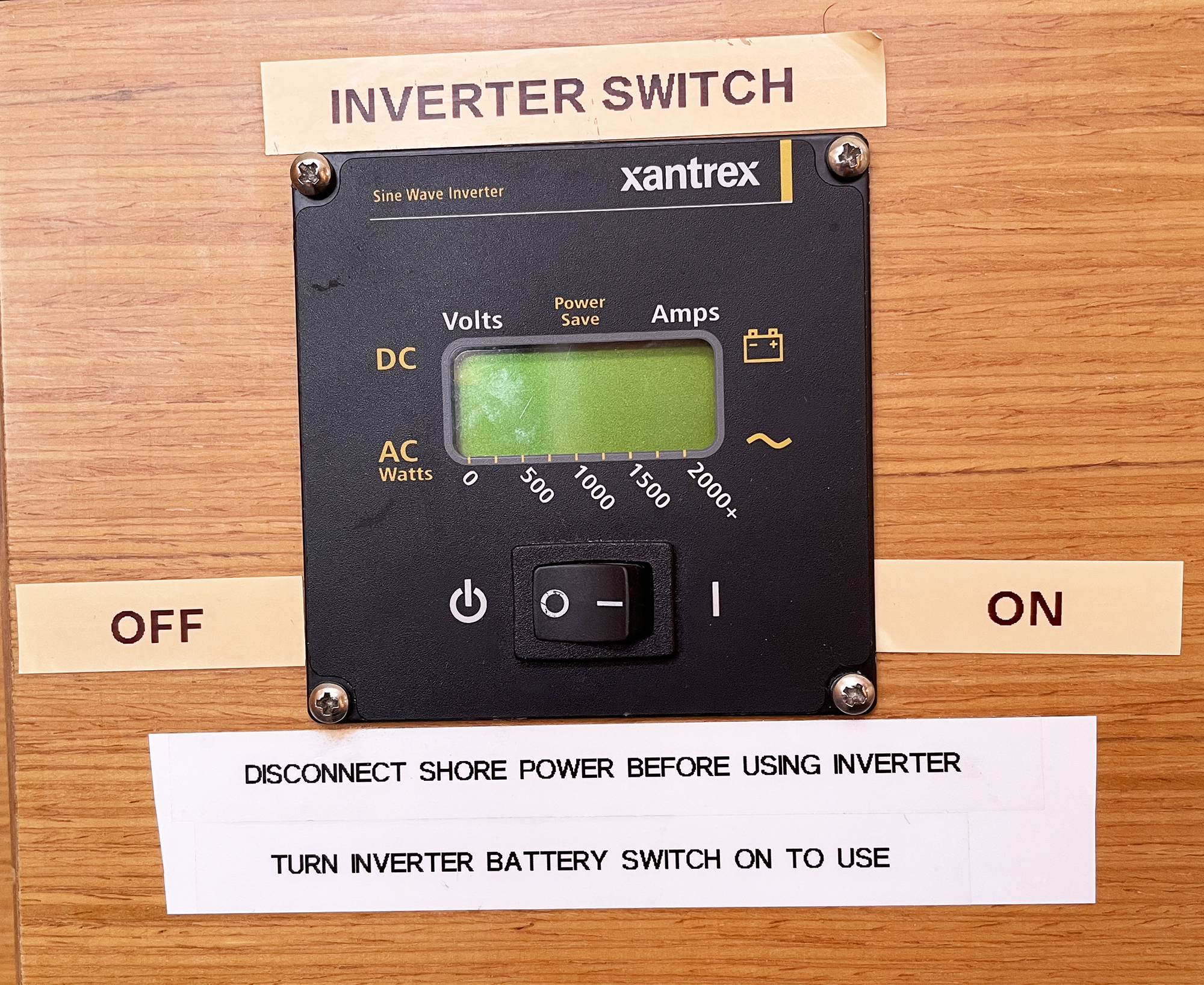
Inverter on SV Ry Whitt.jpg
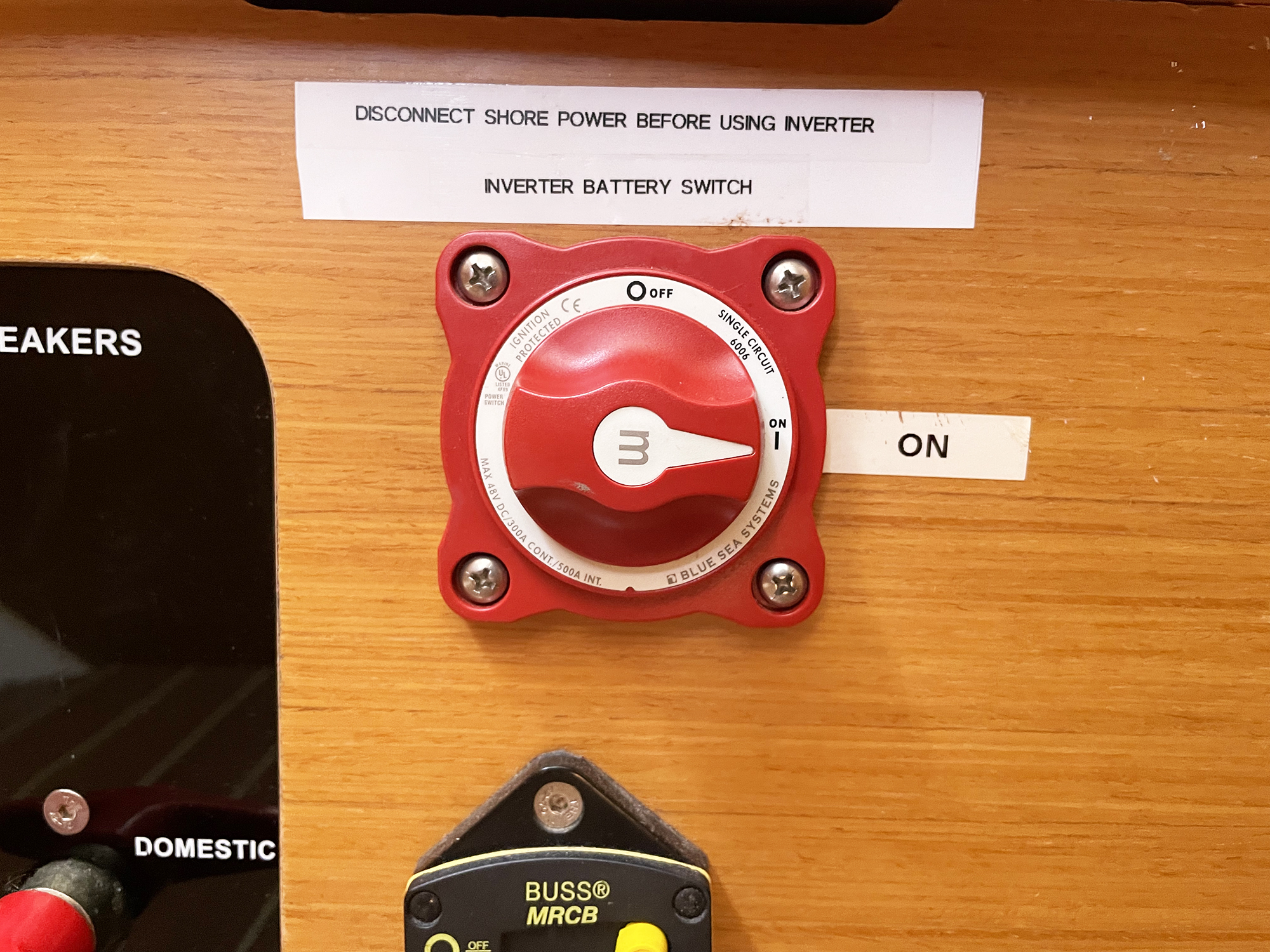
How can I prevent battery drainage or damage?
To learn more about smart onboard power management and preventing battery drainage, see our article Marine Battery and Power Management Basics .
Which MSC boats have inverters?
Some boats in the MSC fleet do not have inverters and supply only 12v DC power when disconnected from shore power. If access to 110/120v AC electricity during your time away from shore matters to you, see the article Choosing the Right Boat for Your Charter and check the fleet spreadsheet to see how boats are equipped.
MSC has one portable inverter that charterers can borrow for boats that do not come equipped with an inverter. Please call or email the office if you'd like to reserve it for your charter (no additional cost).
How can I access 12v power to charge a mobile device?
If your chosen boat does not have an inverter nor 12v USB ports, you can keep your mobile devices charged by bringing your own 12v USB device charger, such as the one pictured here.
12v USB charger.jpeg
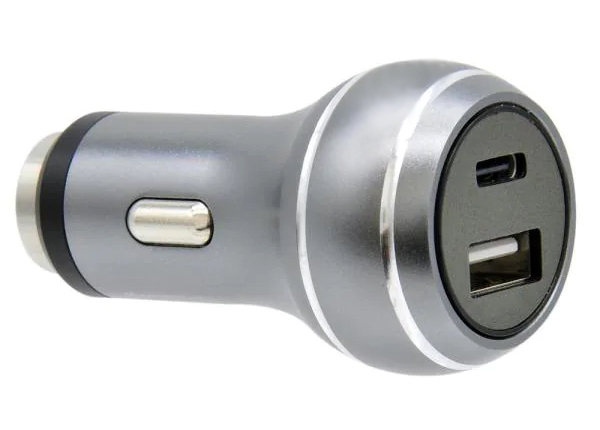
Can I run the refrigerator away from shore power?
Please do not run refrigeration when the boat is disconnected from shore power. If you're wondering about refrigerators and the power they draw, see the article Charter Boat Icebox and Refrigerator Basics and Best Practices .
Do you have a question about using electricity onboard? Please email our friendly office team and we'll add your question to this article.
Share This Page
Testimonials.
I've taken two classes at MSS&C and was very happy with the program. This is also a great club with lots of opportunities for camaraderie and practice on the water. The boats in the fleet are fantastic and kept in tip-top shape. I highly recommend for all sailors and would-be sailors!
Since many, many years, I had the dream to sail underneath the Golden Gate bridge. On October 14th last year, my dream became true. Thanks to our dear friend Aaron Fritz who made it possible and organized this cruise for us. With this adventure I was able to achieve one more milestone on my sailing career.
Finally on the water, it was great! Full moon made the flows even stronger and it was like sailing in a washing machine.
I did my sailing education in the English Channel, where the situation with the wind and flows is comparable to the San Francisco Bay. So I felt pretty much "at home" being on the helm in the Bay.
I hope our skipper Stan Lander enjoyed this day cruise too. We, definitely did! It was an unforgettable experience for all of us.
A very big thank you to all of you who made it possible, that my dream became reality! Also thank you for the MSC flag I got at the end of the day. It found it's place in my study, where I can see it daily.
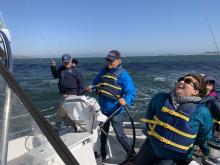
I try to get out on the water every week: out the Gate, around Angel, up Raccoon - I love it all. After 18 years as a member of OCSC in Berkeley, I learned to sail the bigger boats at Modern by taking ASA 103 and 104. My ASA 104 instructor Dave Russell was terrific. Also, Captain Bill Moreland has been very generous in giving informal advice whenever I’ve asked him. Thanks to Bill, I no longer have any anxiety about docking!
View All Testimonials
Follow us on Social Media

Modern Sailing School & Club
Sausalito Location 2310 Marinship Way, Sausalito, CA 94965 (415) 331-8250 (800) 995-1668
Berkeley Location 1 Spinnaker Way, Berkeley, CA 94710 (415) 331-8250 (800) 995-1668
Map / Directions
You are here.
- BOAT OF THE YEAR
- Newsletters
- Sailboat Reviews
- Boating Safety
- Sailing Totem
- Charter Resources
- Destinations
- Galley Recipes
- Living Aboard
- Sails and Rigging
- Maintenance

Sailboat Electrical System Upgrades
- By Ed Sherman
- Updated: April 7, 2021
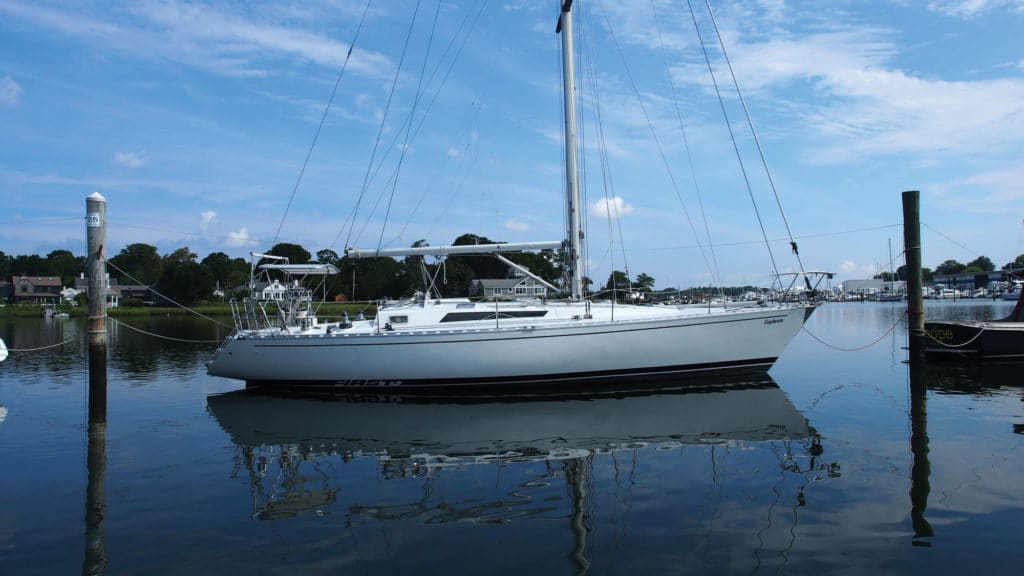
If you’ve been attending boat shows for the past 10 or 20 years like I have, you have surely noticed significant design evolutions from the major sailboat builders. Wide beam carried all the way aft to a plumb transom—which often articulates into a sweet boarding deck, sometimes even opening up a garage for a tender and motor—are becoming the norm. Dual helms and twin rudders are commonplace, and you’d be hard-pressed to find a boat without installed air conditioning and sophisticated refrigeration systems. Boats 30 feet and longer often have a bow thruster as an option, and shore power is standard equipment.
Recently I had the opportunity to turn on the not-so-way-back machine and take a trip to the 1980s to remind me what life on board back then was about. Let me share with you some of my observations and what I would consider changing if I were to buy such a boat.
The sample boat here is a Germán Frers-designed 1983 Beneteau First 42, offered for sale by Dave McKenny at Brewer Yacht Sales in Rhode Island. It is a one-owner boat that was repowered about 10 years ago, and its hull and deck have been repainted. The interior woodwork is the classic dark bright finish of the era and is in excellent condition. More common to that time, the boat has two proper sea berths port and starboard, amidships above and behind the standard saloon settees. And the upholstery has been updated.
The onboard electrical and electronic systems, however, are mostly original, with the exception of a fairly recent autopilot, a 1,000-watt DC-to-AC electrical inverter and an Isotherm seawater-cooled DC refrigeration/freezer upgrade for the original icebox in the galley. The boat has no shore-power system installed, which amazingly was not that uncommon back then. There is no bow thruster or electric windlass; winches are all sized properly but fully manual. So the question is, what would I do to bring this boat’s almost-40-year-old electrical/electronic systems into the new century?
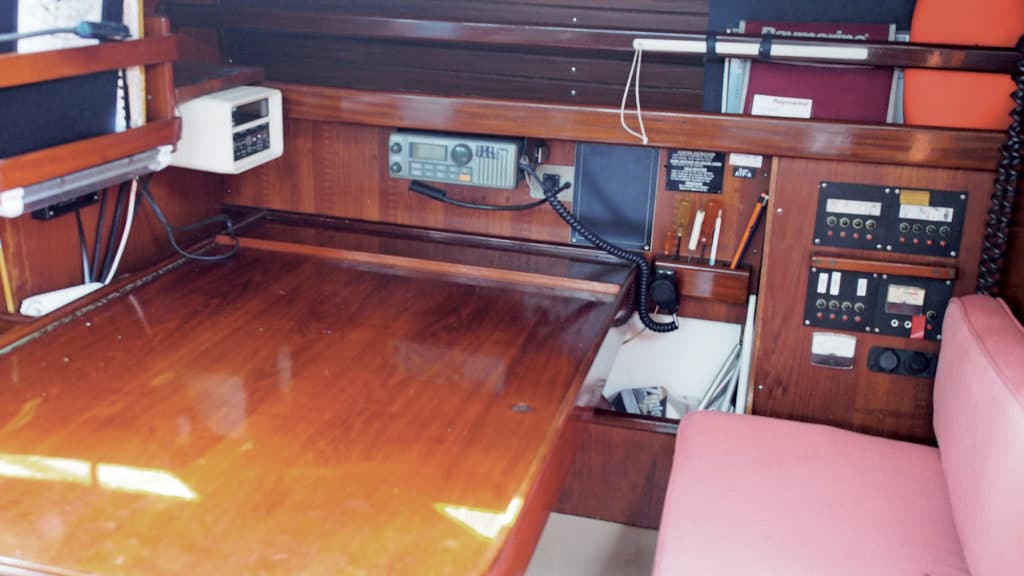
Step one would be to analyze the existing source of electrical power. Currently the boat is equipped with a pair of Group 31 flooded-cell lead-acid batteries. They get recharged by a stock 65-amp alternator controlled by an ancient Balmar voltage regulator. This battery bank has an amp-hour capacity of about 200 amps, but unfortunately flooded lead-acid batteries like these suffer from cycle-life reduction if they get continually discharged below about 50 percent of their capacity. In effect, this boat currently has about 100 amp-hours of power available for running accessories.
In my dream redo, this would not be adequate, and I consider it marginal even as the boat is equipped now without a bit of engine run time to keep those batteries charged.
For me, one of the first upgrades would be to replace these batteries with a pair of group 31 absorbed glass-mat batteries. AGMs have considerably higher recharge-acceptance rates compared with flooded-cell batteries, and can be discharged up to 80 percent of capacity, meaning that engine run times will be at a more acceptable level when away from the dock, at least in terms of electrical-power generation. Upgrading the alternator and voltage regulator to a 100-amp Balmar set would also be on my list for this boat to minimize engine run time.
My intention is to add quite a bit more electrical equipment to this boat, and I prefer not to run things such as alternators near their maximum capacity for extended periods of time. Limiting the amount of full output extends their potential service life considerably.
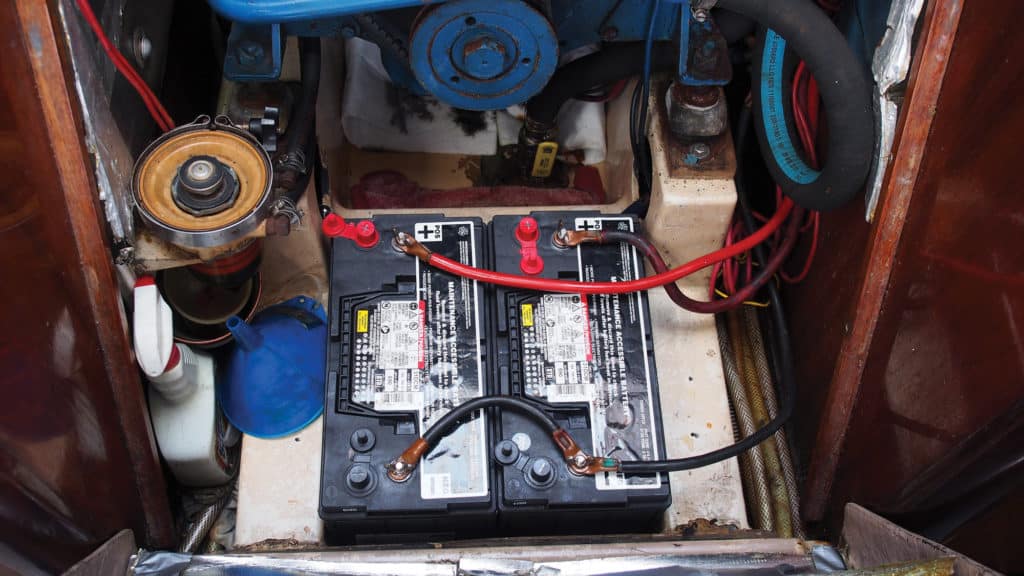
Plug and Play
AC power on board today is almost a must for boats that are going to be berthed at a dock. Yes, global warming is real, and sleeping on board without air conditioning at this point in my life just isn’t happening.
I’ve lost my enthusiasm for cold showers as well. In the old days, we used sun showers hanging from the boom in the cockpit and got by just fine, but that was then and this is now. The luxury of hot water on demand is not too much to ask in this day and age. So besides adding air conditioning to this boat, we are going to need to add a water heater and appropriate plumbing to deliver hot water to the galley and two heads.
The current refrigeration system, an Isotherm ASU unit, is only a 12-volt, and I would think about swapping that out for a 12-volt DC/120-volt AC unit. Or, as a money saving measure, I might just leave the 12-volt unit in place because I’m going to be installing a proper battery charger to keep my new AGM batteries charged up anyhow. We’ll let the charger replenish the power used by the Isotherm unit.
The bottom line here is that the boat is going to get shore power installed for the first time. The question becomes whether a 30-amp system or a 50-amp system will be needed. Determining that requires performing a load analysis. Here’s how I would go about doing it.
First we have to determine how many Btu we’re going to need to cool the boat. A visit to marinaire.com will connect you with a calculator that will provide the Btu per hour needed to air-condition the boat in either moderate or tropical environments. I chose moderate for this boat because based on MarineAire’s world map, only South Florida is in its tropical zone, and the plan for this boat is to stay in the mid-Atlantic to Northern states the majority of the time.
Based on the calculator results, I still came out needing one of the company’s largest units, which can produce 16,000 Btu of AC and 17,000 Btu of heat when needed. This unit draws just under 11 amps of AC power at 110 volts.
My new water heater will draw 13 amps, and I’ll need another 8 amps for my P-12 Blue Sea 40-amp battery charger.
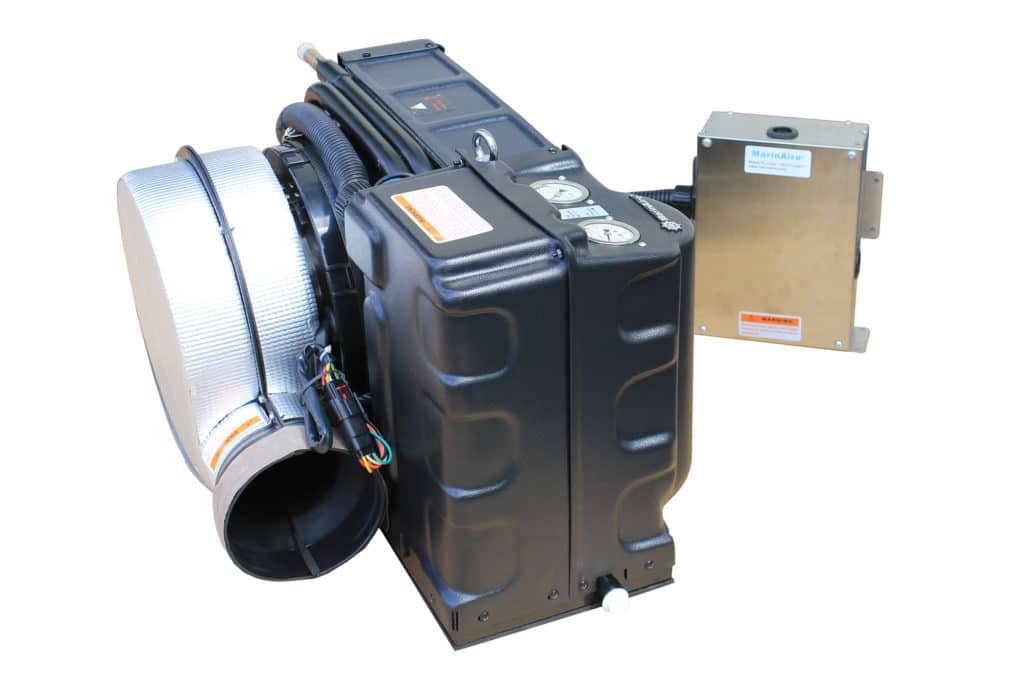
With an air conditioner, water heater and battery charger plugged in and running, we’re looking at just over 30 amps of AC power needed. That figure does not include any provision for a microwave oven, coffee maker, hair dryer or any other small AC appliance while at the dock.
Knowing this opens up two options for shore power: either a 50-amp service or possibly two 30-amp setups. The potential problem here is the marina itself; many don’t offer a 50-amp option at the dockside pedestal. There are myriad adapters available that would allow you to tap into multiple outlets to get to 50 amps, but remember: You don’t want to pull more than 30 amps from a 30-amp service.
One additional shore-power consideration on this boat is the 1,000-watt DC-to-AC inverter that has been installed. This was possibly done to facilitate running a laptop at some point, or maybe an electric shaver or small hair dryer. It is located in the aft head compartment, so I’m going with the shaver idea.
My inclination would be to relocate the inverter behind a panel in the navigation-station area, probably under the settee at the nav station, and resize it to a 2,000-watt unit. I would add a dedicated battery to supply DC power to the inverter and make sure the battery is connected to my Blue Sea charger. Since I am going to be running only intermittent loads from the inverter, a group 27 AGM will get the job done.
Note that I am not considering a generator for this major upgrade. Space is tight, and I don’t want to carry the extra weight. This is a performance cruiser, and I want it to stay that way. Besides, my plan is to stay mostly in slips when traveling, and so I’ll have access to shore power when I need it.
A Wednesday-night race series is in the plan as well, so I won’t be adding a bow thruster, anchor windlass or electric winches. For the occasional overnight away from the dock, I will still have the power I need to microwave some popcorn and run a laptop to check a weather forecast or watch a downloaded Netflix movie.
Side note: I have no plans to add solar panels or a wind generator either. I love the lines of this boat just the way Frers designed it.
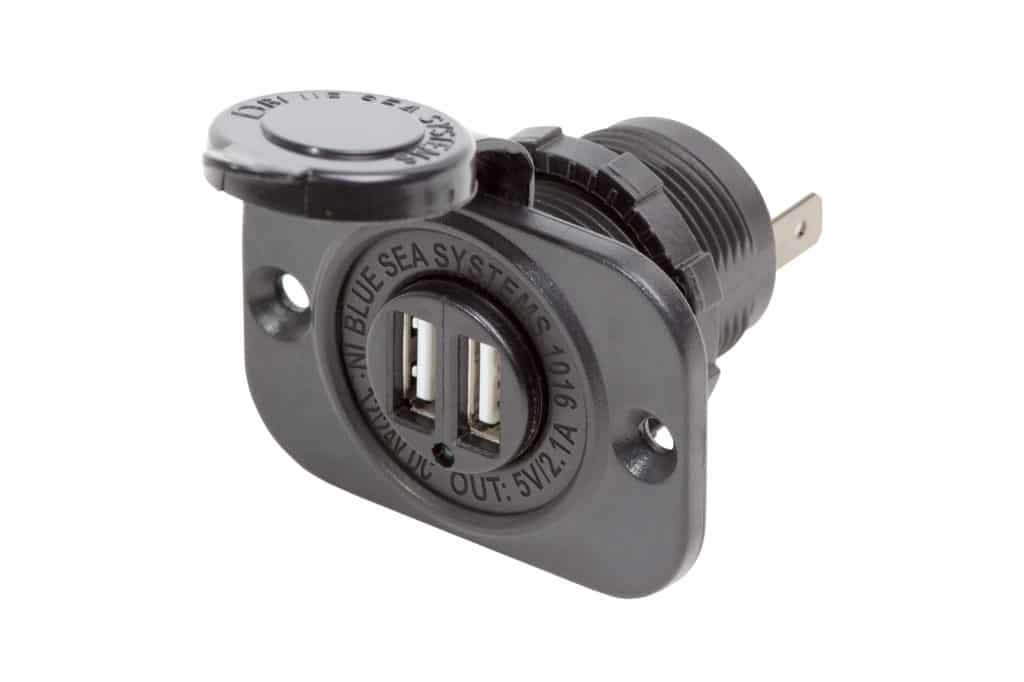
Based on the proposed changes to the electrical system, a new AC/DC combined panel is in order. The boat is currently equipped with 12 DC circuits and no AC circuits. We will also need to modify the battery-switching system, so that will allow the three new batteries, combined, to be separated.
For the panels, Blue Sea, Paneltronics and Bass Products are all possibilities. I just need to take some measurements to see what will fit where the existing panel is mounted. The design will also depend on whether I decide to go with a single 50-amp shore-power service or two 30-amp services.
In either case, rather than having two cigar-lighter-style outlets, we’ll swap those out for a pair of Blue Sea USB plug adapters, which are more relevant in today’s world.
Instruments and Toys
With the exception of the autopilot, the original onboard electronics need to be replaced. A pair of multifunction displays are in order here, with one mounted at the traditional nav station down below and another in a pod at the helm. An updated VHF with digital selective calling and possibly integrated AIS will also be needed. And since trips north to Maine from Annapolis will be part of the plan, we’ll add radar. Air, wind and speed instruments will also be integrated via NMEA 2000. Since coastal cruising is going to be the primary use for this boat, satellite communications will not be part of the permanent upgrades.
I’m not a television person, so a boat with a flat-screen TV that rises up from behind a settee and interfaces with the chart plotter means nothing more to me than just one more thing that can break and need repair. I do have an iPad loaded with my favorite tunes though, so some speakers and a small AM/FM stereo set that connects to my iPhone or iPad via Bluetooth will augment the good company I plan to have on board for entertainment.
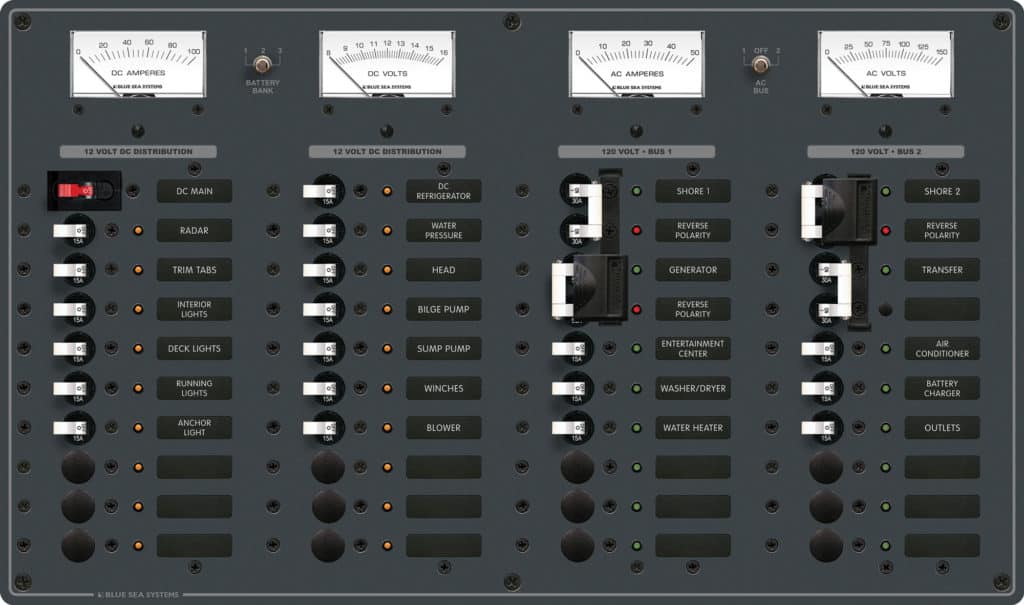
Dollars and Sense
The used-boat market has a huge inventory these days, and there a lot of really great boats available for any price range—and at considerable savings compared with the cost of a new boat.
This Beneteau First 42 that I have my eye on has an asking price of $59,900. Although there is no direct comparison for the 2020 model year from Beneteau, a similar boat in this size range would cost over $200,000. That’s at least a $140,000 differential.
That can buy a lot of upgrades!
The proposals I suggest here will not be inexpensive, but when compared with the cost of a new boat with similar equipment (much of it optional), you can come out tens of thousands of dollars ahead with careful selection of the right used boat. I think the biggest part of any decision here is to be totally honest with yourself about your genuine needs versus your dreams and desires.
Ed Sherman writes frequently on a range of technical topics for CW. He is a longtime Boat of the Year judge, and recently retired as vice president of the American Boat & Yacht Council.
- More: electrical systems , Electronics , Hands-On Sailor , How To , print 2021 mar
- More How To

How To Prioritize Your Sailboat’s Spring Checklist

How to Protect Your Spars from Corrosion

Sailing Totem Refit Series: The Forward Head Makeover

Fatty Goodlander: Dealing with Chafe While Cruising

TradeWinds Debuts 59-foot TWe6 Smart Electric Yacht

Good Bread for Good Health

Center of Effort

The Halfway Point: Sailing to Bermuda
- Digital Edition
- Customer Service
- Privacy Policy
- Email Newsletters
- Cruising World
- Sailing World
- Salt Water Sportsman
- Sport Fishing
- Wakeboarding
No products in the cart.
Sailing Ellidah is supported by our readers. Buying through our links may earn us an affiliate commission at no extra cost to you.
Comparing 6 Energy Sources For Electricity On A Sailboat
We usually have all sorts of equipment onboard our sailboats that require electricity, like navigation instruments, navigation lights, VHF Radios, refrigeration, interior lighting, and much more. We also want to be able to charge our devices, laptops, cameras, drones, and other appliances onboard.
And for that we need electricity.
Sailboats generally get their electricity from shore power in a marina or from their batteries at sea. The batteries get power from the main engine’s standard alternator, often combined with one or more of the following sources:
- Additional alternator
- Solar panels
- Wind generator
Hydrogenerator
We tend to choose our sailboat’s energy source based on how much power the equipment onboard requires. It is also important to consider what else we want to power up onboard, especially if we’re going to plug in 110V or 230V equipment. Let us take a closer look at how we get electricity onboard.
Electricity onboard a sailboat and why we need it
We need electricity on our sailboats for many reasons. The engine requires power to start, and our navigation equipment and sailing instruments need electricity to operate. We must keep our navigation lights on when it gets dark, and sometimes we want to have the interior lights on.
Another super essential and power-hungry device we ideally want to keep running is the fridge. We don’t want our food to go bad, and we certainly want to avoid having to drink warm beer. Since we live in modern times, we also want to charge all our devices and toys as well.
In the end, our sailboat has become quite power-hungry for electricity, and when we leave the shore and unplug the shore power, we have to rely on our batteries to supply the energy we need. Let us have a look at some common equipment often found onboard sailboats.
Equipment that requires electricity onboard a sailboat
If you are slightly unfamiliar with sailboats, you may wonder: What equipment do we often have that requires electricity? Check out this list I made from the top of my head. Remember that it is highly individual how much stuff we run on our boats, but these are pretty typical items:
- Engine starter
- Navigation lights
- Chart plotter
- Sailing instruments
- Sound system
- Interior lightning
- Water pumps
- Bilge pumps
- Refrigerator
- Laptop charger
- Phone and tablet chargers
- Camera chargers
- Drone chargers
- Head torch chargers
- 110V/220V inverter
This list can get endless . We definitely want a reliable way to keep us supplied with energy, and we also need a way to store this energy.
Sailboat batteries and how to charge them
The batteries on a sailboat get charged by the engine’s alternator by standard. Relying on the alternator is fine if you don’t require too much energy to power your equipment onboard and don’t mind running the engine often.
Modern sailboats usually carry several batteries. It is standard practice to have one or two batteries dedicated to starting the engine and a separate series of batteries, called house bank , to supply the rest of our needs. It is a good idea to separate the starter battery and the house bank to avoid draining the starter battery by mistake.
The starting battery is usually 12V (DC voltage) for most sailboats with a diesel or petrol engine. Our house bank can sometimes be either 12V or 24V, depending on your sailboat setup.
But if you are a liveaboard sailor or have lots of power-hungry stuff and equipment, it quickly gets tedious to run the engine all the time to keep the batteries charged up. Luckily, there are many excellent additional alternatives to keep your batteries charged without running the main engine.
This brings us to the next topic. Let’s look at some excellent options to keep our sailboat fed with energy.
6 energy sources for sailboats compared
It is pretty common to have a combination of two or more of the following energy sources. They all have pros and cons, but it is hard to tell which one is the best as it depends on yourself and your needs.
I am personally a huge fan of solar panels, and I get 95% of all my energy from this wonderful and sustainable source. And my list of equipment that requires electricity is way longer than the one earlier in this article…
Let us have a look at each of the six most common additional sources of power used on sailboats:
Main Engine Alternators
Most sailboats have a main engine, and the main engine has an alternator that generates electricity when running. The alternator is connected to the batteries and will keep charging them for as long as you run the machine in most cases.
Standard alternators don’t always give a high enough output to charge larger battery banks within the timeframe we have the engine running. One good option here is to add a secondary high-output alternator, which can be great in combination with another power source.
Pro’s
- Comes standard
- It gives power as long as the engine is running
- An additional high-output alternator can turn your engine into a generator
Con’s
- It requires fuel and maintenance to keep the engine running
- Usually noisy
Generators or gen-sets are typically found on larger sailboats with plenty of space to install them. It works similarly to the main engine but generally has a much higher output of 110V or 220V.
The generator then supplies your mains power the same way as if you plugged your cable into shore power at the key or marina. Generators come in various sizes with different outputs. Some are units you can move around, while others require to be permanently installed.
- High output
- It makes you able to run AC and other high-power appliances
- Great for redundancy and off-grid living
- Require fuel and maintenance
- Generators can be expensive
Solar Panels
Solar panels are great and can give you significant amounts of energy, especially when sailing in tropical and sunny climates. They require some space and careful placement to be efficient, as shading significantly reduces their output. And on a sailboat, many things can give shade, especially the mast and our rigging.
A common practice is placing solar panels on top of the sprayhood, bimini, or on a separate solar arch on the back of the boat. You can, of course, do a combination and even use flexible panels on the front deck.
I have also seen many people mounting panels on the sides of the boat with a mechanism to flip them up to face the sun when needed. You need additional solar chargers to feed electricity from the solar panels to the batteries, and the best option here is to use MPPT chargers.
- Modern panels are highly efficient
- If you have enough space for it, you can rely purely on solar in a sunny climate
- Require very little maintenance
- 100% renewable energy
- It pairs exceptionally well with lithium batteries
- Solar panels and chargers are reasonably priced compared to the other options
- Prone to shading
- Not efficient in areas with less sunlight
- They take up significant space on the boat
Wind Generator
Wind generators can be great if you sail in a windy area like the Caribbean . They can constantly run 24/7 as long as there are sufficient winds, which can be very helpful. Especially at night when solar panels won’t give you any output, and you don’t want to run the engine or generator to wake up everyone on the boat.
However, they won’t give you high power output and may not cover your needs unless you use electricity sparely. They can be great if you have the space to mount one or two in addition to another source. Just make sure not to mount them in a way that can shade the solar panels.
DuoGen makes a hybrid that can work as wind and hydro generator, which can be a good option for many, but they start at a relatively high price.
- A steady supply of power in windy areas
- Suitable for supplying electricity at night
- Reasonably priced
- Not efficient without wind
- It takes up significant space on the boat
- It may be difficult to mount in combination with solar panels when you want to avoid shading
A hydro generator generates power through its propeller when dragged through the water. Hydro generators often look like a small outboard engine mounted on the back of a sailboat, but you can also get them in variations that can be permanently installed underwater.
The hydro generator will generate electricity as long as the boat moves through the water, but not when you are at anchor. You can typically expect an output of around 10A when sailing, which can be very helpful underway.
If you spend a lot of time at anchor, as most cruisers do, your best bet is probably to combine the hydro generator with another source like solar or wind generation.
- A steady supply of power underway
- Require little maintenance
- Only work underway
- Most models take up significant space on the back of the boat
- Hydro generators are expensive
A less popular source of electricity is the methanol fuel cell. It uses a chemical process to generate energy that requires methanol as fuel. They usually come as standalone units and are simple to install, but the output is relatively low compared to some of our other alternatives.
Another thing to consider is the need to carry methanol fuel onboard, which is highly flammable. Some people like them a lot because they don’t make any noise, can be placed anywhere, and require little maintenance. There are also fuel cells that run on propane instead of methanol.
- Works in any conditions
- Easy to install
- You need highly flammable fuel to run it
- Fuel cells are expensive
Final Words
Everyone has different needs onboard their sailboats regarding how much energy they require to run their electric equipment. Especially cruisers and liveaboards have relatively high energy demands to keep the electronics alive, and relying on the standard alternator isn’t feasible.
From my experience, solar panels are the way to go if you intend to sail in sunny climates, and many cruisers seem to agree. The sun is an infinite source of green energy, and given that you can fit enough panels, they will be able to supply all the renewable power you want.
I have two 285W solar panels hooked up to a 50A MPPT charger, and I easily get 25-50A of power on a good sunny day, enough to leave my lithium batteries topped up by mid-day.
Solar panels often overperform way above their stated output, as seen in the solar charger dashboard in the picture below.
Combine solar with another source, and you have great redundancy for cloudy days. I am very skeptical about fuel cells, however. Still, technology is moving forward rapidly, and I think we will start to see hydrogen fuel cells becoming feasible in the future, which is exciting!
I am curious to know, how do you supply your sailboat with electricity? Leave a comment below!
Sharing is caring!
Skipper, Electrician and ROV Pilot
Robin is the founder and owner of Sailing Ellidah and has been living on his sailboat since 2019. He is currently on a journey to sail around the world and is passionate about writing his story and helpful content to inspire others who share his interest in sailing.
Leave a Reply Cancel reply
Your email address will not be published. Required fields are marked *

Press release: PowerUP Energy Technologies receives grant to develop fuel cell generators for Namibia and Pakistan

Press Release: Finnish sailing yacht, Fuga collaborates with Estonian CleanTech start-up PowerUP Energy Technologies
A guide to powering your sailing boat in 2021.

Energy for navigation, refrigeration, lights or other electrical items requires a reliable power source on any sailing boat or yacht. Depending on the desired luxury and convenience on the boat, energy consumption may vary greatly. If you have an engine, it’s possible to charge the batteries. But a boat’s engine will use almost as much fuel to charge batteries as it does when motoring. Idling your engine still produces emissions and pollutants that negatively affect our environment and our health. Running your engine purely for charging batteries can also harm your engine, as it is not designed to run below its rated level.
Before choosing which energy system is best for your needs, you first need to establish:
- What are you trying to accomplish (power navigation, run refrigeration, etc.)?
- How much electricity do you require?
- Do you need to modify your boat’s electrical system to meet those requirements?
- Do you have the appropriate weather conditions (wind, sun, etc.) to “fuel” the generator?
Let’s review the different sources for energy generation and storage on boats and yachts!
STORAGE OF ENERGY
Batteries are required to store the electrical energy received from the generator or other sources in order to dispatch it depending on electrical devices demand. The batteries provide a real-time and on-demand reply to your boat electrical requirements.
Marine batteries are designed specifically for use on a boat, with heavier plates and robust construction designed to withstand the vibration and pounding that can occur onboard. For this reason, marine batteries are usually more expensive than automobile batteries, which can tempt some boat owners to purchase an auto battery instead of a marine battery. Don’t make that poor decision. A marine battery will last longer and be more reliable than an auto battery in a boat.
There are several types of batteries available. The main ones are:
- Open lead-acid batteries , the most common and oldest technology for cruising sailboat. The electrolyte fluid level has to be checked on a regular basis.
- Sealed lead (or lead-calcium; valve-regulated lead-acid VRLA) batteries require less maintenance due to the fact that no liquid level check is needed. The chemical reaction ensures battery operation for the lifetime indicated by the manufacturer.
- AGM and gel batteries . The liquid electrolyte is replaced by a gelled solution, there is no risk of leakage or liquid level issue, the performances are higher and the lifetime is better. But this type of batteries are heavier and more expensive.
- Lithium-ion batteries . Lithium batteries have a high specific energy density, which allows them to store more energy in batteries of smaller size and mass. They are also distinguished by high current output and have a number of advantages. But even their charge lasts for a very limited time. The major constraint to their development is a high selling price.
You should choose your marine battery based on the purpose of the battery:
- Marine starting batteries provide quick but powerful spurts of energy over short periods of time and are designed to start the engine and be rapidly recharged by the engine alternator. A starting battery should not be used for trolling motors or powering appliances.
- Marine deep cycle batteries are designed to discharge slowly over a long period of time and to withstand several hundred charging and discharging cycles. A deep cycle battery is the right choice for powering an electric trolling motor and other battery-powered accessories such as audio systems, a windlass, depth finders, fish locators, and appliances. Deep cycle batteries should not be substituted for starting batteries.
- Marine dual-purpose batteries combine the performance of starting and deep cycle battery and are a good choice on smaller when there’s no room for two batteries. While they’re able to perform the tasks of a starting battery and deep cycle battery, they’re not as efficient as separate batteries.
GENERATION OF ENERGY ON THE SEA | CHARGING
During sailing, the batteries need to be charged. It is a good idea to have at least two independent energy sources. In general, all methods of autonomous charging can be divided into two groups:
- Renewable energy sources (solar panels, wind, hydro generators, hydrogen fuel cell generators)
- Fossil-fuel powered sources (diesel generators, petrol generators, etc)
A renewable source of generation is a good option and a good safety backup for boats. There are several types of systems you can use including wind generators, solar panels, water generators, or a combination. Some systems can keep your battery fully charged while your boat sits on the trailer, on a mooring or at the dock, or can be used during long journeys while you are underway.
Let’s go through the renewable sources one-by-one.
- SOLAR PANELS
Solar panels can be used on small and large boats effectively, they weigh relatively little, and can be flexible. But there are also many risks, especially for a small yacht. Primarily the risk of damage to the panel itself, controller, cable or contacts. The second is the lack of sun. It may happen that for several days the sun does not shine, or you go in such courses that you cannot effectively direct the panels to the sun – they stay in the shade of the sails. On a positive note, they require minimal maintenance, don’t make noise, last up to 25 years or more, and are safe. In general, solar panels are a good complement with some other solution to produce electricity.
Solar sails (solar cloth sails) are being made around the world, where photovoltaic film is attached to each side of the sail.
- HYDROGENERATOR
Water-powered generators are relatively inexpensive but require a flow rate to give charge. There are two main types: towed spinner generators and shaft generators. With both, however, a minimum speed of 4 knots is recommended, as below this speed, the energy generated is negligible. At low speed of the boat, there is no charge, but there is resistance. There is also a risk of damage – collision with floating objects and breakdown of the propeller. Plus, the risk of damaging of cables, charger and contacts.
- WIND POWER
Wind generators use the apparent wind to produce renewable electricity through an alternator. They can be fixed on a mast or gantry. Wind generators have the potential to produce power 24 hours a day whether sailing or at anchor. If there is a strong wind, or you are underway, they can usually put out more current than solar panels. Wind generators, however, can be noisy, require regular maintenance and have the potential danger of rotating blades. Because of the huge sails of a sailing boat and long booms it is easy to mechanically damage such a generator.
- METHANOL FUEL CELLS
Methanol fuel cells have good advantages – they work quietly and rather economically. They can be located inside the yacht and continue to work with any wind conditions and sea state. They don’t require too much special care while operating, but they do fail sometimes. Although we listed methanol fuel cells as renewable energy source, they do emit some carbon dioxide.
- HYDROGEN FUEL CELLS
One of the most promising technologies for boats and yachts – hydrogen fuel cell generators. They are a relatively new, progressive energy source that run on renewable fuel. In principle, in the future, hydrogen could be generated even on board the yacht itself, increasing the autonomy. Of course, there are some big limitations that must be overcome, as the electrolysis process is relatively inefficient. Among the advantages – hydrogen fuel cells are lightweight and compact systems that provide a high charge current (the UP400 model gives 32 A). It works in extreme conditions, is quiet and provides clean energy without emissions.
NON-RENEWABLE SOURCES
There are non-renewable sources available and quite often they tend to be more friendly for your wallet. Of the advantages, fossil-fuel generators can charge rather quickly. But more often than not, this is where the pros are over. This energy source is the least environmentally friendly of all. It runs on fossil fuels, has a very unpleasant exhaust, from which the head constantly hurts. It does not work while boat is heeling or bumping. Read more about the advantages and disadvantages of diesel generators here .
Whether you are long-range cruising folk or enjoy the weekend getaway on a boat, energy is a sensitive topic for all boats. You get what you pay for, so consider your options carefully and it’s always best to consult an expert.
Photo source.
Related posts

Green Innovation in Heavy Industries: Transforming Construction and Mining

PowerUP Hires a New CTO With Extensive Background in Fuel Cell Technology

Hydrogen Myths
- Skip to main content
- Skip to primary sidebar
- Skip to footer
The Boat Galley
making boat life better

Figuring Out Your Power Needs on a Boat
Published on August 31, 2022 ; last updated on January 18, 2023 by Carolyn Shearlock
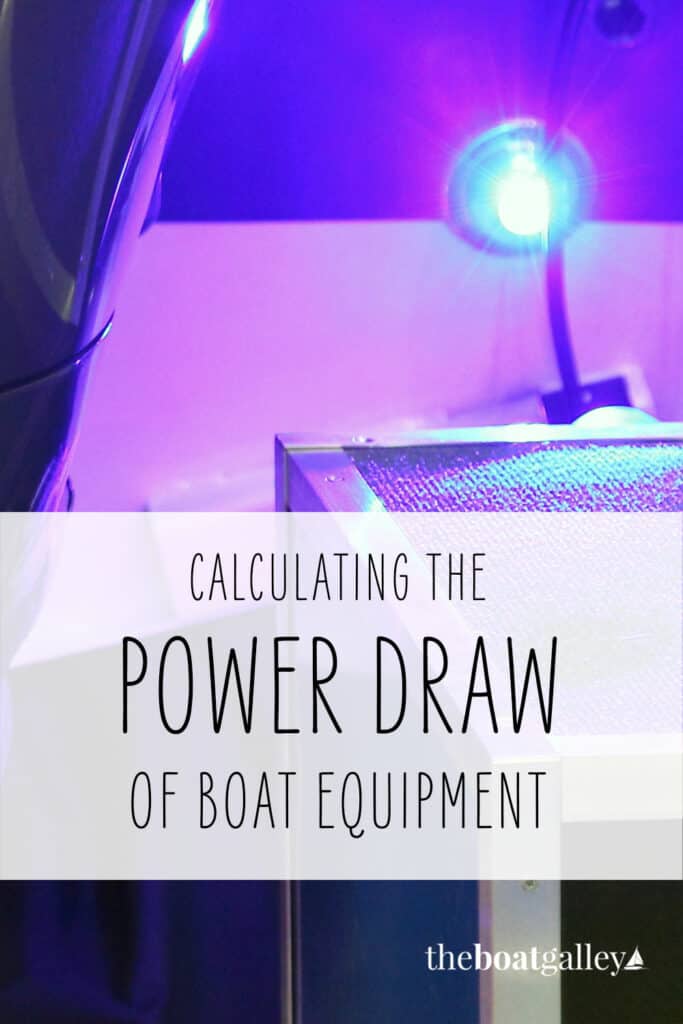
I’ve written about several devices to keep you cool in the summer heat. Unfortunately, most of them require power (wind scoops and swimming are the exceptions). Getting any new device requires an analysis of whether you have enough power and whether this is what you want to use it on.
Since we began cruising in 2002, Dave and I have felt that sufficient power aboard is an important part of making living aboard and cruising a sustainable lifestyle.
On one hand, we seek out low power draw options for our needs. One of the reasons that I first began The Boat Galley in 2010 was to talk about the power draw for various galley appliances and pass on techniques for cooking with few to no electrical appliances. Still, it can be difficult to find the power used by various devices.
Many items either tell how much power they use in watts or tell the amps for being plugged in to a standard house (110v) power supply. On boats, we generally look at power draw in terms of 12v amp-hours.
If an item natively uses 12V power, and tells the amps, it’s simple. Take the amps stated and figure how many hours a day you’ll use the item. Let’s take my Caframo fan that draws 1 amp and assume that I have one running 24 hours a day – that’s 24 amp-hours.
If the items draw is marked in watts, you begin by dividing watts by 12 to get the 12V amps. Then again, figure the number of hours you’ll use the item and multiply. The mattress cooler that I talked about last week uses 8 watts, so .66 12V amps. 8 hours a night, and the total power used is 5.28 amp-hours.
If the item runs on 110V (normal shore current in the US), you multiply the amps by 10 to get the 12V draw, then combine with average usage to determine the amp-hours. Since there’s a bit of inefficiency when using an inverter, I always round the result up.
So now you know how much a new gizmo that you’re thinking of getting will cost in terms of power.
Next, check out power available. Start with how much battery capacity you have in amp-hours, and how many are usable (generally 50% for lead-acid batteries and 80% for lithium). Then see how much of that you’re using and how quickly you’re recharging it from wind, solar, generator and alternator. We find that a battery monitor is essential for knowing exactly what is going on (read about ours here). Do you still have power available? Is it sufficient for your gizmo?
If a particular item requires too much power for your system, you can decide to do without, check alternatives that may draw less, or decide to increase your battery capacity or your power generation capability. In general, look first at battery capacity if you are fully charged early in the day, and power generation if you are rarely reach a full charge.
Everyone has a different idea of what an acceptable lifestyle is. For us, it’s lights, a refrigerator and freezer, a rechargeable vacuum, plenty of power for computers and other electronics, and fans and other devices to stay cool without air conditioning. We also have a watermaker, but it runs off our generator not the batteries.
We have 300 amp-hours of lithium batteries, which charge much more efficiently than lead-acid and also can be discharged further, which helps if we have a cloudy day or two. We have 495 watts of SunPower A+ solar panels. Additionally, we have a Honda 2200 generator, which is needed for power in December and January when the days are short and the sun is lower to the horizon, so the solar panels don’t produce as much; we rarely use it other than for the watermaker the other 10 months of the year. And finally, there’s an alternator on the engine which helps out when we’re motoring.
Getting a new device – particularly one that will require more than a minimal amount of power – isn’t a snap decision. Just realize that you have a certain number of amp-hours to spend, and then decide how you want to spend them. And if you don’t have enough for something you really want, figure out how to get more.
Be sure to subscribe to The Boat Galley newsletter to keep up with what we’re up to and get helpful tips and encouragement from the water.
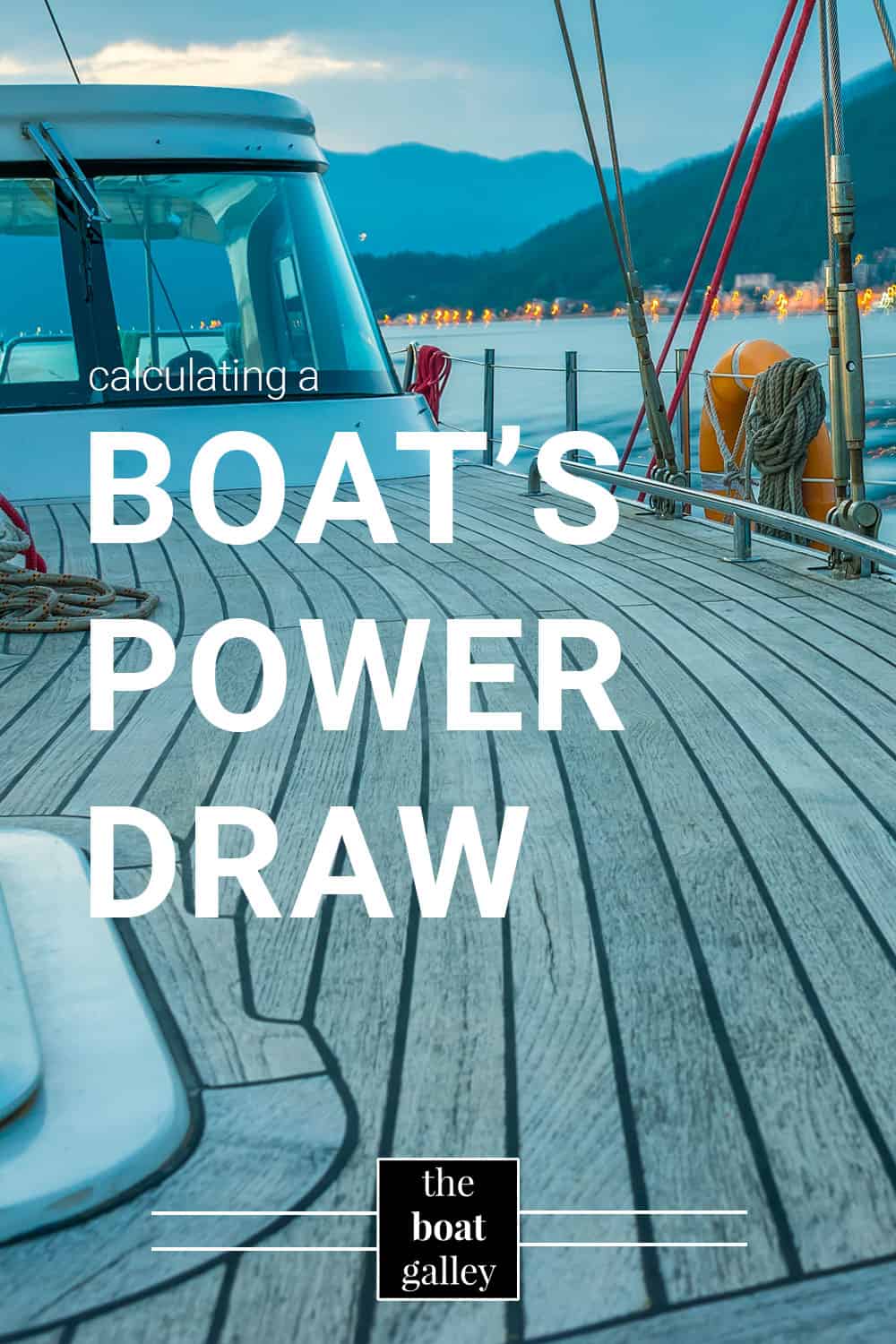
And check out our other courses and products

Find this helpful? Share and save:
- Facebook 81
- Pinterest 23
Reader Interactions
Leave a reply cancel reply.
Your email address will not be published. Required fields are marked *
Each week you’ll get:
• Tips from Carolyn • New articles & podcasts • Popular articles you may have missed • Totally FREE – one email a week
SUBSCRIBE NOW
- Questions? Click to Email Me
- Visit Our Store


16 Ways to Generate Electricity on a Sailboat: The Complete Guide

How do you manage to generate electricity when you’re out on the water in a sailboat? If you aren’t a sailor, you may have never even considered this. For the person who just bought a boat, however, this is the guide for you.
How do you generate electricity on a sailboat? One can generate electricity e ither with generators, batteries, or adaptions made to your boat to capture energy from the water, sun, or wind.
While generators and batteries must be recharged or refueled somehow, there are a few unique modifications you can make on your boat to make it self-sustaining, at least in terms of electricity. If you don’t want to put in the work for making changes to your boat, a generator or battery is an easy fix.
Stored Energy Options to Generate Electricity on a Sailboat
These are all the options you can use to generate electricity while on the sailboat. Unlike the options listed in the following section, these are all portable stores of energy you can bring onto the sailboat with you. They store energy, whereas the second group produces it.
There are many different ways you can bring energy onboard with you for your usage while on your boat. Two different common ones you’ll find are:
And one you won’t find so often is:
There are some similarities between the three, especially when you’re looking into electrical generators versus batteries. We’ll start with generators before moving to inverters and finishing with batteries.

1. Hybrid Generators for Using on a Sailboat for Electricity
There are many ways to generate electricity on your sailboat, but the one we’d most suggest to you is hybrid generators. These are generators that can run a variety of ways. You don’t have to dock every time your generator runs out of fuel, but on a cloudy day, your generator won’t be dead on the water.
Many electric generators, which we’ll cover in the following section, have other options aside from plugging it in and charging it of an outlet. For instance, they’ll also have a tank for gasoline or diesel. In other cases, you can purchase a solar panel to work with your generator.
When it comes to choosing something for your sailboat, you want something with multiple methods of fueling or charging it. At least once, you’ll probably forget to fill up the tank with fuel before you cast off, or forget to charge your electric generator.
You’re also better prepared in emergencies with a hybrid generator. If something happens, your generator may run out of diesel before you can contact anyone. With a solar or electric option, you’ll have backup in any emergency.
2. Electric Generators for Using on a Sailboat for Electricity
Electric generators are one of the newest things, and one of the best options on the market for this purpose. Many have available kits you can add to change how you charge it, from swapping out the plug to fit a different outlet to adding a solar panel for green energy.
Electric generators come in a variety of sizes, from small ones intended to be used on camping trips to charge your phone or DVD player to large ones you can run your house off of in emergencies. They’re essentially a large battery pack, similar to the one you may have for your smartphone.
The best part about an electric generator is the cost of charging it versus the cost of filling up a generator running on fossil fuel. While it may take a serious amount of energy to fully charge an electric generator, it’ll only be a small increase in your electric usage compared to the cost of filling up daily.
You’re also maintaining a cleaner airspace for yourself and everyone around you, including the marine life you’re sailing above. If using green energy is important to you, read down about solar generators, or look for an electric model with a solar panel option.
3. Diesel Generators for Using on a Sailboat for Electricity
This is probably the most commonly used source of electricity when people are on their boats. Diesel generators are easy to find at any local home improvement store for a variety of prices and uses. Diesel generators also tend to outlive their gas counterparts.
Typically, diesel generators are loud, smelly, and bulky. However, they’re easy to purchase in store, as is diesel. Newer models are becoming smaller and quieter, with better regulations on the exhaust system. Older generators have exhaust systems that allow more diesel out into the air, leading to the smell.
Diesel engines also will last you a long time. These are frequently considered the workhouses of engines, putting out an impressive amount of power as well as outliving their competitors. You’ll also go through a good amount of oil, as diesel engines are famed for burning through it.
However, things like electric generators and battery packs are taking over the market for sailboat electricity. These are less expensive and smaller, without the diesel smell of the generator. They’ll also save you on expenses by not requiring diesel or any other fuel.
4. Bio Diesel Generator for Using on a Sailboat for Electricity
These are almost a subset of diesel generators. However, they run on a different fuel which requires slightly different parts, so they deserve their own recognition.
Diesel engines are surprisingly easy to convert to bio diesel. If you have a diesel generator but want to convert it to bio diesel, you’ll only need to find a shop near you offering the service. Most diesel car shops won’t work on your generator, though, so you’ll need to find someone specializing in it.
Bio diesel is a great option if you’re trying to minimize your carbon footprint. Instead of being made completely of diesel, which is a limited resource and a damaging one to burn, bio diesel is mixed with a biological resource. Typically, this is used frying oil mixed with a ratio of 80/20, diesel to oil.
Neither diesel nor bio diesel will last long in storage. Gas, diesel, and bio diesel all have a shelf life of about a year, after which you shouldn’t use it. After a year, the fuel becomes thick and gloppy while the oil separates out of it. It won’t burn properly in this state and will damage your generator.
5. Gas Generators for Using on a Sailboat for Electricity
These are the second-most popular generators for using on your sailboat. Again, we prefer to avoid these because of the noise and the smell, which can be a real buzzkill. However, you can find many quieter options on the market compared to what used to be there.
As a rule of thumb, gas generators are going to be less expensive or smelly than diesel. During the winter months, gas is cheaper than diesel as well, which lowers the overall cost of the generator even more. Why do so many people prefer diesel over gas generators then?
Diesel generators typically outlive other engines. This isn’t always true, of course, but think of the many old diesel semi-trucks that are still running on the road every day. Diesel generators can also sit with fuel inside them for longer, while gas generator’s engines will gunk up quickly if you allow fuel to sit in them.
Gas generators will be easier on your bank account, both initially and down the road, compared to diesel generators. If you remember nothing else about choosing a fossil fuel generator, remember that diesel lasts forever, but gas is less expensive initially and on the long run.
6. Propane Generators for Using on a Sailboat for Electricity
Propane generators aren’t nearly as popular as gas and diesel generators, but they do have their advantages. While diesel and gas can’t sit around for very long, propane doesn’t have that issue. You can safely hold propane for over a year, and it will still burn just the same.
On the flip side, propane is more expensive. We’ve established that gas generators are the least expensive; propane generators are the most expensive to keep fueled. Propane is harder to come by and used significantly less than gas or diesel, which can also be a problem if you’re relying on your generator.
In a power outage affecting stores, you won’t be able to get gasoline or diesel. This is because the pumps won’t be working. With a propane generator, however, you don’t have to worry about pumping anything. While everyone else is driving two towns over for diesel, you can be on your boat.
7. Solar Generators for Using on a Sailboat for Electricity
We’ve already gone over the electric generators that can be adapted to use solar energy, but there are also generators that use solar power as their primary source of energy. These typically come with larger solar panels than just the electric generator adaption kits do.
When it comes to generators, “panels” may not mean what you’re thinking of. Instead of ones you’ll see on people’s houses, these are often foldable for travel. If you have the option between the two, go for one that folds in order to save space on the boat.
If you’re interested in living off the grid on your sailboat, solar generators are one of the best ways to do so. You won’t have to come in for fuel ever again, and you’ll be using only green energy. With some panels, you can even hang them from your mast when you aren’t moving.
If you look into travel generators, you’ll find a lot of solar options that don’t require extra panels at all. Travel generators are typically solar or electrically powered and are smaller. If you’re only looking for something small, look into these, as the solar panels are the entire outer case of the generator instead of a separate panel.
8. Inverters for Using on a Sailboat for Electricity
What is an inverter, and how is it different from generators or batteries? An inverter is simply a device that converts DC energy from a battery or a serious of batteries into AC power for whatever your power needs are. AC power is what most devices use.
A lot of inverters are switching to using lithium-ion batteries, which are rechargeable and last the longest. In the sections below, we cover batteries separately, as you can purchase them without an inverter. There are also pros and cons to each type when it comes to using them.
The best part about inverters is that when the battery goes bad inside it, you don’t have to buy a whole new inverter. Instead, you’ll only have to replace the battery. When you’re replacing the battery, however, remember that you must replace it with the same kind of battery you removed.
The only reason you’ll need to replace your inverter is if it’s damaged, you want to switch to a different type of battery, or the battery goes bad inside the inverter and damages it. If you notice any damages to your inverter, be careful, as damage in the wrong place could lead to a shock.
9. Lithium Batteries for Using on a Sailboat for Electricity
Lithium batteries are one of the most common types of batteries out there today. Whether it’s in your electronic cigarette or in your phone or your gaming device, you probably have more in your home right now than you realize. Not all of them are this small, though.
You can purchase lithium batteries large enough to run whatever you may need on your sailboat. These are rechargeable, which you can do a variety of ways depending on the battery, and last a long time. They’re also quiet, something generators very much are not.
You can also use several lithium batteries at once to power different things. The only thing you’ll need to remember when buying a lithium battery is that it isn’t set up for you already. You’ll still need an inverter to work with it to convert the DC power to AC power before it can be used.
For more information on using lithium batteries or battery banks, which we cover in the next section, look into TrioTravels’s post on using lithium batteries to bring electric to his sailboat. He goes into deeper details on lithium batteries, battery banks, and how to set it up with your boat.
10. Battery Banks for Using on a Sailboat for Electricity
Today, many people habitually carry a portable battery that they can charge their phone off of when they need to. If you don’t, you may keep one in your car or tucked in your luggage for while you’re traveling. The point is, we nearly all have portable batteries now. How much can they power?
It turns out, a lot. Many of these battery banks use lithium batteries, which we just covered. Whereas you’ll have to make adjustments and adaptions by just buying a lithium battery, battery banks have all that work done for you. It’s as simple as plug and play.
You’ll need to match your battery pack size to what you’re powering or bring multiples. Keep in mind, you won’t be able to plug everyone’s phone, tablet, and laptop into one battery pack. Unlike plain lithium batteries, battery packs typically have a set number of plugs.
The cheaper and smaller your battery pack is, the shorter the amount of time you’ll be able to use it is. If you want to invest in or more battery packs, spend the extra money to get one from a reputable electronics seller, versus the one you can pick up at the dollar store.
11. Open Lead Acid Batteries for Generating Energy on a Sailboat
These are the oldest technology for generating electricity on your boat, but they aren’t the best, as we already covered. The biggest draw of these is their low price point and all the information you can discover about using them with your sailboat, versus anything else.
Open lead acid batteries are made up of an electrolyte fluid inside. As the battery is used, you have to regularly check the fluid level. If it gets too low, you’ll damage the battery casing and risk the fluid leaking out. You also have to be careful when checking the fluid not to spill it.
You can recharge these batteries in a variety of ways, including the most popular today, off lithium-ion batteries. It’s highly suggested you charge them after each use, as they become dangerous when the charge is under 50%.
These are still the cheapest and most widely used rechargeable batteries, despite being the original battery plan from the 19 th century. Being the grandfather of all batteries isn’t even enough to make this one retire.
12. AGM and Gel Batteries for Generating Energy on a Sailboat
These are very similar to open lead batteries, but with the exception of using a gel instead of a liquid. This way, there is no liquid to evaporate or spill out. However, a gel is significantly heavier than a liquid, making it less portable.
Just like with other batteries, this one requires an inverter to change the energy from DC to AC. There are many inverters that come with AGM batteries instead of open lead batteries, the company preferring the more dependable gel.
The gel also improves on performance and lifetime when compared to the liquid. However, as well as being heavier, the gel is more expensive. You won’t be spending nearly as much as a lithium battery, but these aren’t the cheapest either.
13. Sealed Lead Batteries for Generating Energy on a Sailboat
With these, there’s no liquid or gel. Instead, there’s a chemical reaction inside them producing and then storing energy until the manufacturer’s date. After the date, however, you’ll simply have to toss the battery and buy a new one.
This can lead to serious waste if you’re regularly using these. This is why unless you only go out occasionally and use your battery, stick with something rechargeable. You’ll leave a smaller carbon footprint and won’t have to buy new batteries constantly.
If you aren’t using it often, this is a safer option than the open lead batteries because you don’t have any liquid to worry about. On the flip side, it isn’t rechargeable, unlike gel batteries, but it is cheaper than them.
14. A Fuel Cell for Generating Energy on a Sailboat?
Fuel cells are one of the hottest topics right now. If manufacturers could produce a low-cost fuel cell, it would be one of the most ideal solutions for generating energy while out on the water. In fact, fuel cells would be an ideal solution to produce a lot of energy for different needs.
Fuel cells use a chemical reaction inside them to produce energy. This energy can then be harness and used while the reaction is continually taking place in the fuel cell.
Right now, fuel cells are too expensive for the average person to buy. However, in the future, you may find yourself looking into fuel cells. They’re cleaner energy than generators that run off fossil fuels, and they’ll last longer than your typical battery, even a lithium battery.
Unlike other green energy options, fuel cells don’t rely on any externals for power. No matter how cloudy of a day it is, you’ll still be able to have power with a fuel cell compared to solar panels.
Internal Ways to Generate Electricity on a Sailboat
Now that we’ve covered the ways you can bring power onto the sailboat with you, we’ll go into different ways you can create energy while on your sailboat. You’ll only have to use what’s around you and make a few adaptions on your boat.
The best part about these is that you can live off the grid. With battery packs and generators, you’ll have to come back to land to restock, whether it’s fuel or just to plug in and charge. With these options, you won’t have to go back on land to refill your electricity again.
15. Hydrogenerators for Generating Electricity on a Sailboat
Hydrogenerators literally means “water generator.” Just like with wind generators in the following section, these also spin around to produce energy. They’re simply underwater versus up high, using the current of the water instead of the wind.
As you sail, the hydrogenerator uses the water flow to create energy. You’ll need an alternator to work with this one or the next, much like how you need an inverter to use a battery. Alternators simply work to convert the energy of the water flow into usable, AC power.
The only issue with hydrogenerators is the drag they sometimes cause. Because it’s down in the water below you, but hanging off your boat, it’ll slow you down. There are some made to lessen the effects of this.
Also, you won’t be able to gather energy while docked, obviously. The hydrogenerator will only produce energy while it’s moving, so you’ll need to make sure everything is charged at the end of your trip, as you won’t be able to create any energy till you’re far off at sea.
16. Wind Generators for Generating Electricity on a Sailboat
We all know that wind can produce energy for us to harness and use, but did you know you can do that on the open sea? The high-speed winds you may encounter out on the water are ideal for racking up the energy. You’ll also need an alternator to convert the energy.
To set up a wind generator, you’ll have to attach a windmill to the top of your mast. You can affix it to other places as well, but the highest spot is the most likely to have the best winds. You’ll then have your alternator convert the energy into AC power, and the electricity will move forward or into storage, depending on your setup.
Just like with solar energy, this is an ideal option for those looking to move off the grid or only use green energy. However, you may want to keep a backup option. Only during a strong wind that you can feel will the wheel turn and produce energy. Otherwise, it will sit lifeless.
The wind is also felt more strongly when you have one of these installed. The pinwheel atop the master is constantly spinning with the wind, which you can typically feel from inside the boat. This can lead to tipping and an uneven, bumpy ride. However, you use these while docked.
Final Thoughts on Ways to Generate Electricity on a Sailboat
There are many ways to generate or store energy on your sailboat for whatever you may need. The things to keep in mind are what you’ll be using it for, how often, and how important green energy is to you.
With this plethora of options, you should have no problems finding the perfect solution for you. You can also use any combination of these. Try using batteries and inverter and then a generator, or go straight to wind generators and hydrogenerators!
I am the owner of sailoradvice. I live in Birmingham, UK and love to sail with my wife and three boys throughout the year.
Recent Posts
How To Sail From The Great Lakes To The Ocean
It’s a feat in and of itself to sail to the Great Lakes. Now you want to take it one step further and reach the ocean, notably, the Atlantic Ocean. How do you chart a sailing course to get to the...
Can You Sail from the Great Lakes to the Gulf of Mexico by Boat? 
You have years of boating experience and consider yourself quite an accomplished sailor. Lately, you’ve been interested in challenging yourself and traveling greater distances than ever before. If...
- New Sailboats
- Sailboats 21-30ft
- Sailboats 31-35ft
- Sailboats 36-40ft
- Sailboats Over 40ft
- Sailboats Under 21feet
- used_sailboats
- Apps and Computer Programs
- Communications
- Fishfinders
- Handheld Electronics
- Plotters MFDS Rradar
- Wind, Speed & Depth Instruments
- Anchoring Mooring
- Running Rigging
- Sails Canvas
- Standing Rigging
- Diesel Engines
- Off Grid Energy
- Cleaning Waxing
- DIY Projects
- Repair, Tools & Materials
- Spare Parts
- Tools & Gadgets
- Cabin Comfort
- Ventilation
- Footwear Apparel
- Foul Weather Gear
- Mailport & PS Advisor
- Inside Practical Sailor Blog
- Activate My Web Access
- Reset Password
- Customer Service

- Free Newsletter

What You Can Learn on a Quick Test Sail

Cabo Rico’s Classic Cutter

Bob Perrys Salty Tayana 37-Footer Boat Review

Tartan 30: An Affordable Classic

Preparing Yourself for Solo Sailing

Your New Feature-Packed VHF Radio

Preparing A Boat to Sail Solo

Solar Panels: Go Rigid If You have the Space…

When Should We Retire Dyneema Stays and Running Rigging?

Rethinking MOB Prevention

Top-notch Wind Indicators

The Everlasting Multihull Trampoline

Taking Care of Your 12-Volt Lead-Acid Battery Bank

Hassle-free Pumpouts

What Your Boat and the Baltimore Super Container Ship May Have…

Check Your Shorepower System for Hidden Dangers

Waste Not is the Rule. But How Do We Get There?

How to Handle the Head

The Day Sailor’s First-Aid Kit

Choosing and Securing Seat Cushions

How to Select Crew for a Passage or Delivery

Re-sealing the Seams on Waterproof Fabrics

Waxing and Polishing Your Boat

Reducing Engine Room Noise

Tricks and Tips to Forming Do-it-yourself Rigging Terminals

Marine Toilet Maintenance Tips

Learning to Live with Plastic Boat Bits
- Systems & Propulsion
Electric and Hybrid Propulsion for Sailboats
Practical sailor looks at the players in the developing field of electric auxiliary engines.
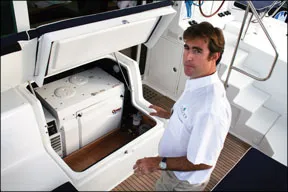
How soon will electric auxiliary propulsion be available to everyman? That depends on whom you ask. Opinions differ widely not just on what type of drive system might surge to the forefront, but even on whether the concept itself is viable. While a handful of companies forge ahead, notably Glacier Bay and Electric Marine Propulsion on this side of the Atlantic, some expected participants are waiting on the sidelines.
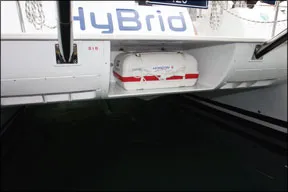
Photos courtesy of Manufacturers
One of the big issues that divides promoters and detractors alike is whether the appropriate way to go in a sailboat is with a pure diesel-electric drive train, with a hybrid electric drive with a diesel generator as back-up, or as a pure electric drive with regeneration capability. We’ll take a look at these and other options later in this article. For now, the short answer is that no single approach suits every sailor all the time.
Simply put, in the diesel-electric system, the electric motor runs only when the diesel-driven generator is running. Such arrangements have long been employed in railway locomotives, submarines, and commercial vessels of many types. In the hybrid system, a large bank of batteries provides the energy for the electric motor and the diesel generator recharges the batteries. On the face of it, the hybrid system offers a certain degree of redundancy in that, assuming the batteries are kept well charged, the boat has a measure of emergency power should the generator fail at an inopportune moment. The hybrid also is capable of recharging its batteries when sailing: Driven by the turning propeller, the motor becomes a generator.
Each of these approaches has its strengths and weaknesses, and while we’ll leave it to their developers to work out the technical issues, we would like to urge anyone contemplating installing an electric drive, or purchasing a boat that has one, to first look very closely at how they expect to use the boat. There’s more entrained in the choice than in picking a flavor at Baskin-Robbins. More on this later.
Among the electric drives currently available in one form or another, or as components, the big variable is operating voltage. Motors are available that run on 24, 36, 48, 72, and 144 volts, and, in the case of Glacier Bay’s diesel-electric system with Ossa Powerlite technology, 240-volt DC. Each supplier will discourse at length on the merits of their voltage choice, but an inconvenient fact haunts the entire field: High-voltage DC is deadly, potentially more so in some circumstances than AC.
While neither form of high-voltage is “safe,” we have a lot more experience with AC aboard recreational vessels than with high-voltage DC. An extensive body of knowledge exists on which to base AC installations so as to make them safe as well as reliable. High-voltage DC is used in a variety of marine and non-marine commercial applications, but these installations are well protected from access by untrained operators.
What voltage constitutes high voltage? That, again, depends on whom you talk to. The American Boat & Yacht Council (ABYC), which sets voluntary standards for the marine industry, defines it as 50 volts and above. Prompted by rapid adoption of high-voltage services in small commercial craft and bigger yachts, though not specifically in propulsion systems, the ABYC is in the process of drawing up guidelines for voltages higher than the 48 volts covered by existing standards.
An absence of standards might not deter individuals from installing an electric drive, but it might impede widespread adoption of the technology. If a surveyor can’t state in an insurance survey that a boat is built according to ABYC standards, that could affect its insurability.
Jim Nolan, who manages the underwriting department for BoatUS, said the company has no clear cut guidance regarding insuring boats with electric propulsion. Each boat is dealt with on a case-by-case basis. A new boat with a factory-installed system would be a good deal easier to underwrite than a one-off or do-it-yourself project, especially in the absence of a standard practice. Lagoon Catamarans’ 72-volt-DC hybrid system, for instance, has qualified for the European standard (CE) certification on the strength of following industrial standards that apply to such applications as fork-lift trucks. Anyone contemplating an electric drive would be well advised to discuss it ahead of time with an insurer and even get a surveyor involved from the outset.
Because of the safety issues surrounding the voltages involved in electric propulsion, Fischer Panda has decided to limit its DC product line to boats weighing 10 tons or less. A company representative we spoke to said that while Fischer Panda currently sells DC generators up to 48 volts in the USA for marine use, it “won’t touch” high-voltage DC because it’s lethal.
A proposed collaboration with Catalina Yachts to fit a diesel-electric system in a Catalina-Morgan 440 never came to fruition due to budget constraints, according to Fischer Panda. But in Europe, Fischer Panda teamed up with Whisperprop to equip a Bavaria 49. (Beyond the fact that one of its boats was used, Bavaria Yachts was not involved in the project.) According to Fischer Panda, after evaluating the Bavaria project, the company decided that the diesel-electric AC system is a niche product that wouldn’t interest their prime market: original equipment builders.
“Although the AC system has some advantages in the improved response of the electric motors … and the quietness of the system, the desired fuel efficiency and weight savings were not evident,” Fischer Panda reported.
Fischer Panda considers the DC system to be more suitable for its North American customers. Although it’s limited in output due to its limited battery voltage of 48 volts, it is still able to power multihulls up to 10 tons.
Currently, much of the movement toward electric drives is taking place in the catamaran world. This makes sense when you consider that a single diesel generator can, in theory, provide all the boat’s electrical needs and also take the place of two diesel-propulsion engines. Taking the lead in the field, Lagoon Catamarans introduced in 2006 the Lagoon 420. Originally offered only as a hybrid, it now is also available in two diesel versions. Corsair Marine is building the Corsair 50 catamaran around the Glacier Bay diesel-electric drive, but the boat’s launch date—formerly set for this summer—has been postponed.
Dick Vermeulen, president of Maine Cat, tried the Glacier Bay system in a prototype power cat, but it failed to meet performance expectations, so production models will have conventional diesels. A number of other cat builders have announced hybrid or diesel-electric projects, but feedback on how they perform is scan’t.
So much for the mainstream—but backwater sailors will go their own way, as they always have. As more vendors and components enter the market, the options for do-it-yourselfers or custom-boat customers become broader and more attractive. However, before going ahead with an installation, make sure it’s appropriate to how you plan to use your boat, and even then be prepared to adapt the way you sail to take best advantage of the system’s characteristics. Here’s a rundown of the various types.
Electric Drive Only
Duffy Electric Boats has for years been building electric launches and lake boats that have the simple capability of puttering around in sheltered waters for a period of time determined by battery capacity and speed maintained. A battery charger powered by shore power charges the batteries overnight. Transferring that approach to a sailboat up to about 25 feet used for daysailing and kept near an electrical outlet shouldn’t be too difficult. It won’t offer the assurance of diesel when trying to get home against current or wind, but a proven 36- or 48-volt system will keep you out of uncharted standards territory.
For a bigger boat, more power, a greater range, or a combination of these requirements, it will be necessary to install a large battery bank and almost certainly will entail going to a higher voltage to keep the amps and the cabling needed to carry them manageable. The boat’s range under power will be limited by the weight of batteries, and while lighter lithium-based technology is on the horizon, for now the standard is lead/acid. The fast charging, but expensive pure lead thin plate (PLTP) Odyssey batteries have attracted particular interest among propulsion enthusiasts.
Electric Drive with Regeneration
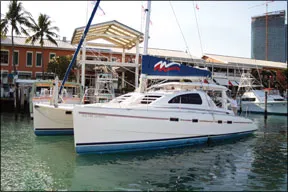
The next level up in complexity is a “reversible” system. When the boat is sailing, the propeller turns the motor, which then becomes a generator. The electricity it makes is used to recharge the batteries. The capability to regenerate extends the boat’s potential range, but the drag on the propeller slows the boat measurably. One hour of regen will not restore the power consumed by one hour of motoring, but if sailing time sufficiently exceeds motoring time, this arrangement offers considerable range.
A regenerating system does have the potential to overcharge the batteries once they become fully charged and the boat continues to sail fast. The solution is, ironically, to give the motor some “throttle,” which reduces the drag on the propeller and consequently the power output. This phenomenon gives rise to a new technique, that of “electro-sailing” in which sails and an electric motor complement each other. At present, the “throttle” must be adjusted by hand, but developers are working on automatic controls. Field trials of existing regen motors such as the Solomon systems suggest that a small regen motor’s ability to match the output of a much higher-rated diesel have been overstated.
Hybrid Electric Drive
A hybrid system adds to the mix an onboard generator, which is used primarily to maintain charge in the batteries, both those for the propulsion motor and for the house services. This arrangement extends the boat’s capability to lie for long periods at anchor, independent of shore power for electricity and without the need to go sailing for the sole purpose of charging the batteries. A hybrid can motor constantly, as long as there is fuel, but it cannot sustain full speed for long periods. This is because the generator is usually rated at a far lower horsepower than that required to drive the boat at full speed.
Diesel-Electric Drive
In a pure diesel-electric, the electric propulsion motor runs only when the generator is running. Storage batteries are not needed for propulsion purposes, and the generator is the source for all onboard electrical power needs. The rationale behind diesel electric lies in the relationship between a diesel engine’s rate of fuel consumption and the load it’s working under. It burns fuel more efficiently when heavily loaded than when lightly loaded. When the diesel engine is disconnected from the propeller, it can be controlled so that it is working in the upper range of its efficiency regardless of how fast the propeller is turning. Nigel Calder’s series of articles in Professional Boatbuilder magazine (www.boatbuilder.com) beginning with the June/July issue delves deeply into the efficiency discussion surrounding these engines. Systems on large vessels are built around multiple generators that switch on or off according to the power demands of the moment. Translating those efficiencies into a smaller boat scenario has proven to be challenging.
Hype vs. Experience
Maine Cat’s Vermeulen, on the company’s website, describes the sea trials he performed in the Maine Cat 45, a power catamaran. He began with a Glacier Bay diesel-electric system with two 25-kW generators, each weighing about 550 pounds.
“With both generators putting out their full power of 25 kW each … our top speed was a disappointing 8.4 knots, and the assumption that electric horsepower was somehow more powerful than conventionally produced horsepower was in serious doubt.”
He replaced the propellers with a pair with less pitch, which allowed the electric motors to reach their full rating of 1,100 rpm, but that only increased the speed to 9.1 knots.
“These are about the same speeds and fuel burns we get on our Maine Cat 41 sailing cat … powered by twin 29-horsepower 3YM30 Yanmar diesels with saildrives and two-bladed, folding propellers.” At the time he installed them, the 25-kW generators were the highest power available from Glacier Bay.

Vermeulen replaced the diesel-electric system with twin 160-horsepower Volvo diesels. At 9.1 knots, they together burned 2.2 gallons per hour, considerably less than the 3 gallons per hour that the Glacier Bay system burned at the same speed. With the twin Volvos maxed out at 3,900 rpm, the boat made 24.5 knots.
Also among the unconvinced is Chris White, well-known designer of ocean-going catamarans. “To date, I’ve not seen any system that makes sense for a cruising boat,” he says, but he might change his mind, “if someone can show me by building one that delivers an advantage in performance, weight, or cost.”
White sees the current bubble of interest in diesel-electric drives as a fad. In the end, he says, you’re getting the horsepower the diesel creates at the crankshaft, which is basically the same whether it’s delivered to the prop via a conventional reduction gearbox or via a generator and an electric motor. Besides, he says, diesel engines and diesel fuel are understood and available anywhere in the world you might take a sailboat. Complex, electronically controlled electric motors are not.
White’s reservations notwithstanding, it’s in the world of catamarans that we’re seeing most of the applications. At first sight, it does seem logical that replacing three diesel engines—two propulsion and one generator—on a fully equipped cruising cat would result in fuel savings. Still, if the generator is big enough to drive the boat at cruising speed (which in a cat is expected to be in the vicinity of 10 knots) and run the air conditioning at the same time, it will be overkill for the times it’s only needed to operate the boat’s services. For this reason, commercial and military diesel-electric systems employ multiple generators that can be switched on and off according to the power demand of the moment.
Corsair Marine hopes that by installing a diesel-electric system in its 50-foot catamaran, it will be able to descend the weight spiral. Where a conventional installation would involve two 75-horsepower saildrives plus a 6-kW genset, it’s fitting a pair of 28-horsepower electric motors, one 25-kW generator, and a 40-amp, 230-volt battery bank. It expects to save about 700 pounds in equipment weight, some of it through the use of high-voltage, low-current systems, which will in turn reduce the rig requirement, thus the structural weight, and so on toward an estimated overall weight savings in the thousands of pounds.
Corsair’s David Renouf estimates that the boat will cruise at 8 knots and be capable of short bursts at 10. He admits that, until the first boat is launched, his information is “based on extrapolation, not proven numbers.” He says that some clients will add a second 25-kW genset to assure longer periods at 10 knots. Currently, the project is running behind schedule, with a launch scheduled before the end of the year.
Cost and Other Benefits
At the present time, there appears to be no reason to install any proprietary electric drive of any description in the expectation of bettering the economics of a standard diesel drive. The motors and their electronic controllers are sophisticated and expensive. A battery bank sufficient to provide a useful motoring range is a big investment in weight, space, and money. When you add a generator and its peripherals, the cost and weight take another upward leap.
Only the simplest system will begin to pay itself off in terms of fuel not burnt, and then only if the boat sees a great deal of use. A diesel-electric system designed to closely dovetail with the way you use the boat may prove to be more efficient over time than a conventional diesel installation, but until enough systems have been installed and used and data from that use compiled and compared, we can’t know that.
So why even consider going electric? Cleanliness and silence of operation are two qualities that make electric propulsion an attractive proposition for a sailboat, but in order to enjoy them, we have to accept the limitations they impose.
A hybrid or a diesel-electric system enables us to have a single fossil-fuel power source for both propulsion and onboard appliances, but whatever fuel we might save as a consequence of motoring more efficiently for a couple of hours will be inconsequential if we run the generator all night to power the air conditioning.
Conclusions
As we go to press, pickings are slim for sailors looking for an electric solution to the diesel problem. Suppliers of components are few, prices are high, and the feedback on long-term reliability is nonexistent. On top of all this is the elephant in the room: the unexplored safety ramifications that accompany high-voltage DC.
However, none of this should deter the dedicated tinkerer who has funds to match his curiosity and who can live within the parameters imposed by electric propulsion.
Practical Sailor encourages our readers to explore the technology, because ultimately, it is the experimenters who bring us the equipment we eventually come to take for granted.
- Pricing Electric Power for a 30-foot Sailboat
- Special Report
- Electric Engines
- Success in the Real World is a Matter of Perspective
RELATED ARTICLES MORE FROM AUTHOR
What your boat and the baltimore super container ship may have in common.
I have gotten excited about repowering my Freedom 30 with an electric motor. A fellow Freedom 30 owner completed his refit about 8 months ago and is very happy with the result, although he wishes he had gone with larger Lipo batteries. He chose a motor from electricyacht.com which sells a 10KW package (quietTorque 10) including motor, performance display, throttle and shaft coupler for $6K. Batteries and charger are extra. The motor does does feature a regen capability. Figure a $10K investment. Big bucks for sure but equivalent to a yard installed diesel repower. I would do the install myself.
I am not a cruiser but have done some lengthy passages from San Francisco to Hawaii. Ideal conditions for regen. I expec between regen and a hundred watts of solar, I could have kept the bank topped up the whole way down despite AP loads, etc. The way back? Not so much. Realistically you would need a small generator and a good stock of gas if you wanted to do much motoring, Having said that, one of the boats that sailed down there with me came home with an outboard as his aux power. I think he had ten gallons of gas.
But I am not planning ocean passages in future, I will be sailing the SF Bay and coastal cruising. When I think about eliminating the engine noise, engine maintenance, fuel tank and tank maintenance, diesel hoses, diesel smell, diesel soot, diesel leaks, r=two boxes of hoses and spares. oil changes, coolant changes, transport and disposal of all the waste to the local recycling facility, lugging fuel jugs down to the boat, storing fuel, filling fuel, buying fuel, worrying about spilling fuel. I mean it just goes on and on.
Frankly, I can’t wait. In terms of range, well, I plan to get a hefty battery bank but I also intend to become a better sailor. I’ll slow down and do more sailing. Gee wiz, what a concept. I’ll be more mindful of time and tide, I’ll take advantage of favorable currents and I’ll be ready to anchor and chill when they are not favorable.
Meanwhile, Elon and his competitors are improving battery technology rapidly. Couple of years from now maybe I double range. But, by then, I won’t be worrying about it because I will be a real sailor.
I look forward to reading an update on the state of electric sailboat propulsion 13 years later…
Most of the time we leave the dock, motor for under half a nautical mile to get out of tiny Wilmette harbor and get the sails up, turn off our much abused Yanmar 3GMF, sail around, turn on the engine, lower the sails, and travel another half a nautical mile back to the dock. Almost all at a very low RPM. But, on occasion we motor or motor sail long distances for hours on end, so a battery only system would not work. But how nice it would be if we had electric propulsion for getting in and out of the harbor.
LEAVE A REPLY Cancel reply
Log in to leave a comment
Latest Videos

The Great Loop – The Basics

Bottom Paint Showdown – Six Paints, One Winner!

Tartan 30 | Boat Review

Fuel Contamination? The Baltimore Francis Key Bridge Collapse
- Privacy Policy
- Do Not Sell My Personal Information
- Online Account Activation
- Privacy Manager

- Forum Listing
- Marketplace
- Advanced Search
- All Topics Sailing
- Living Aboard
- SailNet is a forum community dedicated to Sailing enthusiasts. Come join the discussion about sailing, modifications, classifieds, troubleshooting, repairs, reviews, maintenance, and more!
Power draw on a liveaboard boat
- Add to quote
I am considering buying a boat and live aboard her.. I have a question about power consumption. How much power is there available to use if I know that my Marina will supply 30amps. I am unclear how much that can actually run. I am a web designer so I was hopeing to use my main 24" Dell LCD as not only computer monitor but my TV as well. I will have a laptop driving that, lights at night... fans for circulating the air.. and then in the winter there will be electric heaters going, bubblers to keep the ice from forming around the boat... Can I expect with 30amps to be blowing the fuse often with the usage I am imagining.. is it expected to be juggling power sockets the entire time? I just don't know what to expect... The Marina said they provide 50amps as well.. but this boat I am considering is a Hunter 33 Cherubini... I don't think it can accomodate more than 30amps.. or am I wrong? If not, how much of an ordeal/cost is it to upgrade it to 50amps? I have sooo many questions.. but still determined to join the liveaboard lifestyle.
30 amps is about 3000 watts. If you figure out what the wattage of the different devices you're going to need to use aboard the boat, and that includes the refrigerator, battery charger, lights, computer, etc... you'll have an idea if you're going to need more electrical power or not. A high-powered laptop nowadays is only about 85 Watts...at least that's what my MacBook Pro 2.5 GHz system requires. I doubt a 24" LCD panel is much more than that... The biggest use of electricity aboard a liveaboard boat is the heaters in the winter-time. An electric heater can draw 1000-1500 watts. Chances are pretty unlikely that the Hunter 33 was equipped for more than 30 Amps of shore power. Most sailboats are relatively low power usage over all, since they're dependent on their battery banks when at anchor, and getting used to a huge electrical need at the dock means you'll run into problems when at anchor. A lot of power boats I know of have two 30 Amp or even two 50 amp shore power circuits. There are a lot of ways you can cut your power usage. LED-based lighting goes a long way to reducing your electrical loads. The bubblers will generally not be plugged into the shore power stanchion box that your boat is connected to, nor to the outlets in your boat...so they're not really an issue IMHO. Upgrading to a 50 amp shore-power system is a PITA, and will generally cause you more problems than it is worth IMHO. Most marinas, if you take the boat cruising, do not have 50 Amp shore power feeds for boats the size of yours. If you figure the laptop and panel are 200 watts together, and you use another 1000 watts for the heater in the winter time, you've got about 1800 watts to play around with. A good 40-amp three-stage battery charger would be 500-600 watts, but means that you can power your lighting and such off the DC side of the boat and limit much of your additional 120 VAC needs.
power draw Wow thank you so much for that reply. I feel a lot better about it now. I happen to also have a Macbook Pro so its good to know how much it draws. I just realized I could plug my UPS into my laptop and get some power draw readings from it and get my LCD usage. The heating sounds like it will work out fine. The boat also has a propane heater as well which would be a nice complement to the electric heating I would imagine so I will be just fine. Thanks again, that info is worth gold.
dodgydingo said: Can I expect with 30amps to be blowing the fuse often with the usage I am imagining.. is it expected to be juggling power sockets the entire time? I just don't know what to expect... . Click to expand...
30amps should be fine. The bubblers are generally powered separately from the boat..but a 1hp model will generally draw around 8-10 amps which in combination with a heater and other stuff might trip your breaker. You may need a second dock plug (even a 15amp would work) for the bubbler(s)
More on liveaboard power You also should read up on how batteries work. It is not normally wise to draw down the batteries below 50% capacity without hastening the death of the cells and lowering recharge capacity (more expensive batteries are sometimes more forgiving). On a small monohull, 30Amps of shore power is all you can handle without redoing, at significant cost, the boat's electical system -- totally not worth it. Unless you have air conditioning and a plasma TV, you are unlikely to overwhelm your electical shorepower system. You can increase at sea/anchor capacity by installing more and/or bigger batteries, slap on a solar panel or two for battery top-off, and treat yourself to a good quality inverter to manage AC and DC power automatically. The downside is that this all adds weight. My 2 AGMs are so heavy that they will only leave the boat when replacement is required. I keep them charged with a big solar panel 365. You may also be able to charge your bank faster with a higher capacity engine alternator. It is best to hire a marine electrician to advise you on any significant system upgrades. Electrical is not something your should cheap out on, because if you get it wrong, the cost to set things straight can really snowball.
This brings up a question on Air Conditioning? Does anyone know what a 16000 btu AC unit on a boat draws? I know when I had the Motorhome the AC would set off the 30 amp breakers in campgrounds. Everything else always was ok. Thanks turf
The boat I am looking at is a 36' Hunter and it does have a 16000 btu AC unit. I think that is the standard unit that comes from factory. turf
Geesh I have seen many posts in these forums which have nothing to do with original topics. I thought this one at least had to do with power usage and that the original poster could benefit from any info along those lines as he may at some point like to consider adding an AC unit. Guess rules here just apply to certain people? or maybe you made an assumption and were totally off base, saying most boats wont require a 16000 btu.
You need a 50 amp with 16k and other stuff on board. Start up on 16k is over 30amps and then it settles down into the 20amp range. If you can turn on pump separately from AC you MAY be able to squeak by with a 30a circuit without tripping it by doing pump first...waiting 30 seconds and then starting compressor.
I think I saw 1000 watts mentioned for heating? How cold is it whre you will be? You mention bubblers so I'm guessing it will be pretty cold. 1000 watts isn't much for winter heating. I suspect you'll want 2 1800 watt heaters. Most of the time you can run them on the 900 watt setting but if it gets real cold... Most marinas get pretty sparse in the winter, perhaps there will be extra power sources available then? You will need extra 30 amp cables plus the adapters to break them down to household plugs. Or add a second 30 amp inlet
one other thing you may want ot consider is a dehumidifier the electric kind. This will keep the moisture down in the cabin which means less mold and mildew to content with. I run mine at night mostly and leave the heat turned down. I live aboard a C & C 38 Landfall with 30 amps of power but only an 18 inch flat screen.
Well for heat we live aboard our 33 O/I Morgan in Newfoundland and use one 1500 watt heater, and only turned to the second postion, this gives us lots of heat, sometimes we open a hatch to just cool. If the boat is not cut up inside and the heat has free room to move, it will stay quite comfortable.
theartfuldodger said: Well for heat we live aboard our 33 O/I Morgan in Newfoundland and use one 1500 watt heater, and only turned to the second postion, this gives us lots of heat, sometimes we open a hatch to just cool. Click to expand...
Hi dodgydingo, I live on a 33' Cherubini Hunter with 30 amp AC system. I run a desktop computer and 19" monitor, refridge, electric heater in the winter (usually on the 900 watt setting...it's not that big of a space to heat, but never had a problem at 1200 watt setting either), lights, coffee grinder...u know...all the usual stuff and have Never blown a circuit breaker. Nice choice of boats to live on btw. (...biased)<biased)></biased)>
If you have a electric heater or AC on a boat it should be on a separate 120 AC circuit. In other words 2 120 v ac separate circuits. That would require 2 plugins into the boat. You can use a 50 amp from shore split into two plugins. This will save you overheating the wires and possible fire. Most Air Conditioners draw 17 amps at start-up and drop to 7-10 amps when running. This will require a separate circuit. The main side will contain the rest of the 120V ac,, battery charger, microwave, outlets, and water heater. Depending on your battery state, that alone can eat up most of your amps. For example, let say you preyed your boat off the dock and went sailing for the day or weekend. You deplete your batteries down during this wonderful cruise. You hook to shore power and your battery charger kicks in. Most boats have at least a 30 amp battery charger. On my boat I am OK here because the water heater won't kick in because it is also heated by the engine. If your water heater isn't than that will kick in and you have used up half your amps. If you have anything running on your outlets be very careful what is plugged in. On the DC side you add lights because you came back after a sunset cruise, stereo, PC, water pumps to wash/shower, bilge /sump pumps. Your battery charger can keep up with most of these minus the surges from pumps kicking on. Than there is the refrigeration - the biggest amp draw. Bottom-line, your battery charger is being overworked trying to keep up with all the requirements. Since moving aboard 3 months ago, my learning curve on electrical systems have skyrocketed. I can parallel my 120v AC side to run both panels off of one power cord. I was able to run everything off it (including the 1600 BTU AC unit) until two things happened. I just got back from a cruise or I turned on the microwave. I won't mention my blow dryer. Than I blew all the 120v AC breakers. When I felt the dock power chord and main 120v AC wire going into the boat they were warm to say the least. Dock/Shore power - Can be great to poor depending on the marina. Most say 30 amps provided. It is like Vegas,, a crap shoot on what is coming into the boat. Both voltage and amps can vary greatly on many factors. If you get 30 amps (50 amps) consider yourself lucky. Voltage is anywhere from 107-125 from my experience. One of the biggest factors are how many boats are drawing power off the grind. If the transformer from the power company is small and weak, it can wreak havoc to the marina power grid. I know, we are going through this now at my marina. Power company is replacing the current transformer with double the capacity when the new one goes in this week.
I live aboard my 40' sailboat. I run everything except a/c off one 30A circuit, including *way* too much computer equipment. As it happens, I don't use a coffemaker (percolator instead), but otherwise I basically live as I did ashore. I have a second 30A input for the a/c (a 12k and a 7k BTU unit). For winter heat I use a Webasto diesel heater, but if I was going to use electric heat I would put carefully labeled outlets on the a/c circuit to plug ceramic heaters into (again, distributing loads across the two inputs). On shore power, the big consumers for me (from biggest down): a/c, water heater, battery charger, computer equipment, little stuff.
- ?
- 174K members
Top Contributors this Month

- Forums New posts Unanswered threads Register Top Posts Email
- What's new New posts New Posts (legacy) Latest activity New media
- Media New media New comments
- Boat Info Downloads Weekly Quiz Topic FAQ 10000boatnames.com
- Classifieds Sell Your Boat Used Gear for Sale
- Parts General Marine Parts Hunter Beneteau Catalina MacGregor Oday
- Help Terms of Use Monday Mail Subscribe Monday Mail Unsubscribe
Amp draw on a marine AM/FM stereo/Ipod player?
- Thread starter centerline
- Start date Jan 20, 2013
- Forums for All Owners
- Ask All Sailors
Well, amps = watts/volts You know volts, I assume 12 Most stereos would push out maybe 160 watts... I'm not sure if this an accurate way to figure it though.
Re: amp draw on a marine AM/FM stereo/Ipod player?? Call Crutchfields, they will probably know! I think it is www.crutchfields.com Jack
Ralph Johnstone
Re: amp draw on a marine AM/FM stereo/Ipod player?? I have noticed that my Xantrex Link 10 battery monitor shows about 1.5 A when only the Kenwood CD player is on. Doesn't matter what the Kenwood is doing either, MP3, IPOD, CD, AM, or FM, the amp draw is about the same. Now mind you, no big woofers or tweeters here .................. that may consume more power.
Stu Jackson
Re: amp draw on a marine AM/FM stereo/Ipod player?? Ralph's right, all the rest is conjecture. Our Link measures the stereo we have (Sony car radio with CD changer PLUS a powered subwoofer) at around 1.0A at reasonable volume. If you're doing it for an energy budget, then the power draw at 1.0 to 1.5 A is more than adequate since the only other variable is the amount of hours you use it, right?
Re: amp draw on a marine AM/FM stereo/Ipod player?? We don't boombox or even rock out the fish so when the stereo is playing it's using about an amp. But I can watch the ammeter jiggle while Eric Stone sings. ;D
Stu Jackson said: Ralph's right, all the rest is conjecture. Our Link measures the stereo we have (Sony car radio with CD changer PLUS a powered subwoofer) at around 1.0A at reasonable volume. If you're doing it for an energy budget, then the power draw at 1.0 to 1.5 A is more than adequate since the only other variable is the amount of hours you use it, right? Click to expand
Re: amp draw on a marine AM/FM stereo/Ipod player?? You can buy an ammeter at Harbor Freight for $3.99 which will measure the power draw of the stereo with enough accuracy to satisfy the kind of number that you are looking for. All of the stereo amps/receivers are a little different so measure yours to see what it needs to run the way you run it.. MaineSail posted some stuff a couple of years ago that showed the power being consumed by the rig he was playing.. It is an easy measurement.. Good Luck.. !-2 amperes is in the ballpark.
why don't you post the model number? Did you try the manufacture's web site?
Anonymous 121765
I just read thru this thread and one thing that puzzled me was no mention of reading the specs in the manuals that came with the units. Your AMP info will be listed there. If having no manuals, you can find them online. Download them and save to your computer. CR
I have a Dual marine stereo. The manual has no info on watts or amps required. Nothing even on the info plate on the stereo itself. It does however have a 10 amp fuse built into the unit at the back. I only run the 2 speakers it came with, however I'm sure if I would use 2 more and the subwoofer the stereo can support the draw would go up significantly. I was kind of ticked off that there is no other info about the power draw. I just ran the wiring to the size of the 10 amp fuse.
philwsailz said: Run the radio quiet and you will use less. Just know "sundowners" often cause radio current draws to go up. They also make you more popular and better looking but that's another topic... Click to expand
All U Get said: How many amps or "sundowners" do you think it would take? I'll write it down for the other Mainers. All U Get Click to expand
To put science behind it and refute those bogus claims on the cartons of most radios, consider this. First off, there is Ohm's law where we have P=Power in Watts V=Volts I=current in Amperes R=resistance, (actually a misnomer when taling about speakers since thay are AC devices, hence R=Impedance to keep it in the vernacular of the commom man, but impedance =Z to be totally correct. Impedance varies with frequency) These equations are true: P=IV V=IR To answer the question or refute the myth of peak power lets use math to come up with an expression which isolates Power, Voltage, and Resistance: Lets express V=IR this way: I=V/R and then substitute it in the first eqaution P=IV. The result is P=V^2/R Mobile speakers are normally a nominal 4 ohms, (usually 3.6-ohms or so), so lets use a value of 4 for R. An electrical system in charging with a motor running will have upwards of 14 volts, but we are sailors right. Lets assume a value of V of 12, since of course we call these 12-volt systems, right? Using this math, and assuming 100% efficiency, (most class AB electronics devices are only about 40% eficient, but hey we are in fantasy world) we can see that we get this. P=12^2/4 =36 watts Since a mobile stereo has 4 speakers, the math, assuming 100% efficiency says the total power of the radio, if 100% of the power going in comes out the speakers, is going to be only 144 watts. Not the 200 or more often claimed. When we plug in the efficiency factor that is common, we will see that the radio is good for about 60 watts total power, or 15 watts for each speaker. This is the defacto pure science and cannot be argued. Unless we look at it another way: Suppose the radio runs consistently just under the current draw required to blow the radio fuse. Most radios are fused ast 10 amps. Back to the equations, and using P=IV, we can see that for a current of 10 amps and a voltage of 12 volts, there is ONLY 120 Watts of power available on the power wiring to do everything in the radio... Any more and you blow the fuse... Sorry for the tangent, but I share these things in order to do my small part in educating folks to look deeper on the specs to determine the real power poutput of a given device. When considering purchase, and using power output as a decision criteria, one cannot use the BS numbers provided on the carton. They are not based on any reality I know of... Know that you can dig and often find a group of specs under a rataings guideline known as CEA 2006. This ratings standard was developed by an industry group to provide a level playing field for comparison of power output numbers. Know you will often find devices with both a bold PEAK power in big bold letters, and then find the CEA2006 numbers somewhere else. This is not a perfect scenario, as you the consumer have to dig to find the truth, but it is at least better than shoping blind with the bogus peak power numbers.... BTW, Centerline, the fact that you called two mobile audio shops and got the answers you did makes me laugh, and cry. The mobile electronics industry has lost its core competency. Does it matter that a stereo is going in a sailboat? Really????? It is sad that you can't find real audio experts anymore.... I deal with it every day.....
navigator97
Phl, the entire 12V DC (more likely 12.6V DC) does NOT reach the speakers. The voltage level at the speakers is significantly less than 12V - it is closer to 1V or so of AC audio signal. All in all the DC current draw is more likely to be about 0.5A DC form the power source. IMHO.
navigator97 said: Phl, the entire 12V DC (more likely 12.6V DC) does NOT reach the speakers. The voltage level at the speakers is significantly less than 12V - it is closer to 1V or so of AC audio signal. All in all the DC current draw is more likely to be about 0.5A DC form the power source. IMHO. Click to expand
I just installed a Fusion stereo with the IPOD insert. When I checked it cranking it was less than 2amps on my battery monitor I believe. I can give you a firm figure next time I'm down there if you like. I was actually surprised.
philwsailz said: To put science behind it and refute those bogus claims on the cartons of most radios, consider this. First off, there is Ohm's law where we have P=Power in Watts V=Volts I=current in Amperes R=resistance, (actually a misnomer when taling about speakers since thay are AC devices, hence R=Impedance to keep it in the vernacular of the commom man, but impedance =Z to be totally correct. Impedance varies with frequency) These equations are true: P=IV V=IR To answer the question or refute the myth of peak power lets use math to come up with an expression which isolates Power, Voltage, and Resistance: Lets express V=IR this way: I=V/R and then substitute it in the first eqaution P=IV. The result is P=V^2/R Mobile speakers are normally a nominal 4 ohms, (usually 3.6-ohms or so), so lets use a value of 4 for R. An electrical system in charging with a motor running will have upwards of 14 volts, but we are sailors right. Lets assume a value of V of 12, since of course we call these 12-volt systems, right? Using this math, and assuming 100% efficiency, (most class AB electronics devices are only about 40% eficient, but hey we are in fantasy world) we can see that we get this. P=12^2/4 =36 watts Since a mobile stereo has 4 speakers, the math, assuming 100% efficiency says the total power of the radio, if 100% of the power going in comes out the speakers, is going to be only 144 watts. Not the 200 or more often claimed. When we plug in the efficiency factor that is common, we will see that the radio is good for about 60 watts total power, or 15 watts for each speaker. This is the defacto pure science and cannot be argued. Unless we look at it another way: Suppose the radio runs consistently just under the current draw required to blow the radio fuse. Most radios are fused ast 10 amps. Back to the equations, and using P=IV, we can see that for a current of 10 amps and a voltage of 12 volts, there is ONLY 120 Watts of power available on the power wiring to do everything in the radio... Any more and you blow the fuse... Sorry for the tangent, but I share these things in order to do my small part in educating folks to look deeper on the specs to determine the real power poutput of a given device. When considering purchase, and using power output as a decision criteria, one cannot use the BS numbers provided on the carton. They are not based on any reality I know of... Know that you can dig and often find a group of specs under a rataings guideline known as CEA 2006. This ratings standard was developed by an industry group to provide a level playing field for comparison of power output numbers. Know you will often find devices with both a bold PEAK power in big bold letters, and then find the CEA2006 numbers somewhere else. This is not a perfect scenario, as you the consumer have to dig to find the truth, but it is at least better than shoping blind with the bogus peak power numbers.... BTW, Centerline, the fact that you called two mobile audio shops and got the answers you did makes me laugh, and cry. The mobile electronics industry has lost its core competency. Does it matter that a stereo is going in a sailboat? Really????? It is sad that you can't find real audio experts anymore.... I deal with it every day..... Click to expand
- Stereo on standby : 0.85A
- Stereo with IPod on: 1.24A
- Stereo on using tuner: 1.00A
- Stereo on using CD Player: 1.30A
- This site uses cookies to help personalise content, tailor your experience and to keep you logged in if you register. By continuing to use this site, you are consenting to our use of cookies. Accept Learn more…
- Share full article
Advertisement
Supported by
Guest Essay
An Essential Part of Modern Life That Armies Should Never Attack Again

By Peter Fairley
Mr. Fairley is a journalist who has covered power technology and policy for over 20 years.
In late March, after two years of withering attacks on Ukraine, Russia knocked out half of Ukraine’s power supply. Up to that point, Russia’s missiles and kamikaze drones had mostly targeted the Ukrainian substations that push electricity from power plants to consumers. But this time they hit the plants themselves, severely damaging and destroying hydroelectric and fossil fuel stations — all of which are difficult to repair or replace.
When power stops, life grinds to a halt. Lights go out. Sewage treatment stops. Clean water stops. Electric cars, buses and trolleys stop. Elevators stop, trapping older and disabled people. For many, home heating, refrigeration, cooking and clothes washing stops, along with medical devices such as oxygen generators.
Even though the world’s dependence on electricity for all of this and more is growing, power grids are still legitimate military targets, according to both international law and our own military rule book. But there are small, promising signs that could be changing. Early last month, before Russia’s most damaging assaults, the International Criminal Court in The Hague concluded that the country’s pummeling of Ukraine’s power system had already crossed the line and issued arrest warrants for a pair of senior Russian commanders, Adm. Viktor Nikolayevich Sokolov and Lt. Gen. Sergei Ivanovich Kobylash, whose units are accused of launching the missiles. (Russia has denied committing war crimes.)
It was the world’s first prosecution of combatants for attacks on a power grid and an important first step toward recognizing electricity’s growing centrality to modern life. But the global community must now draw bright lines for combatants in future conflicts — and strengthen the hand of future prosecutors — by codifying specific protections for power grids. The international community already attempts to do that for select infrastructure, including hospitals, dams and nuclear power plants, via the Geneva Conventions. It’s time to add power grids to that privileged roster.
For decades, armies have routinely attacked power grids during war. Germany targeted Britain’s grid from zeppelins in World War I, and NATO jets targeted power plants in Serbia in 1999. The civilian fallout from these attacks can be devastating: When the United States knocked out Baghdad’s electricity in 1991 in the Persian Gulf war, water and sewage treatment were disrupted, sparking typhoid and cholera epidemics.
International law is supposed to curb these kinds of attacks; the laws set out in the Geneva Conventions consider power grids “civilian objects,” to be protected in war. But in practice, thanks to myriad exceptions, militaries can justify nearly any attack where anticipated gains outweigh the projected civilian suffering.
Governments often point to electricity’s role in everything from political and military communications to arms manufacturing. According to Russia’s Defense Ministry , the massive strikes last month were necessary because they disrupted enterprises making and repairing “weapons, equipment and ammunition.” But it would seem that the real goal was to terrorize and break the Ukrainian people. Vladimir Putin’s spokesman, Dmitri Peskov, said as much while explaining grid attacks in November 2022 that left 10 million people without power: “The unwillingness of the Ukrainian side to settle the problem, to start negotiations, its refusal to seek common ground, this is their consequence.”
In its Department of Defense Law of War Manual updated last year, the United States says that it views power plants as important enough to a state’s military functions “to qualify as military objectives during armed conflicts.” The Pentagon rule book dismisses civilian injuries and deaths caused by blackouts as too “remote” and “myriad” for field commanders to accurately calculate and encourages them to consider only the civilians affected “very soon after the attack,” such as those at a hospital directly connected to a power plant. But even in that case, the manual hews to the general rule for civilian infrastructure, advising American forces to stand down only where the harm of powering down life support will be “excessive” relative to the gains.
Unsurprisingly, even U.S. military experts on the law of armed conflict have taken divergent stands on Russia’s grid attacks in Ukraine, attacks it continued last week. “At least some” violated international law, wrote one . Another found it hard to “definitively” identify a criminal act.
The three-judge International Criminal Court panel said it had “reasonable grounds to believe” that the officers they seek to apprehend committed crimes against humanity. That charge applies to unlawful acts that are widespread or systematic, and Russia’s grid attacks keep intensifying.
Our military began scaling down its attacks on electrical grids over 20 years ago. Gregory Noone — a captain and former judge advocate in the U.S. Navy who has trained government officials in Rwanda, Afghanistan and Russia in the laws of war — told me he saw a shift in U.S. behavior between the Persian Gulf war and the Iraq war. “We, the U.S. military, took great pride in the fact that we turned all the lights off in Baghdad in the first gulf war. We wiped out their electric grid,” Dr. Noone said. But by the time of the Iraq war, “we realized that wasn’t such a good idea.”
Other countries would be wise to follow our lead and reject wholesale attacks on the grid. It would save lives and prevent needless destruction; it would also help build an unwritten (yet enforceable) body of international law constraining power grid attacks.
But the international community can and should go further. A strong grid protection protocol that explicitly limits power system destruction could be a game changer. It would ratchet up the threat of prosecution, potentially deterring bad actors who might otherwise be tempted to target power generators. The International Criminal Court said a desire to stop further attacks prompted it to unseal the warrants for General Kobylash and Admiral Sokolov. The hope is that field officers directing missiles and drones may think twice before they order these kinds of attacks in the future.
While Mr. Putin may never face consequences for plunging Ukraine into darkness, General Kobylash and Admiral Sokolov may never leave Russia, for fear of being picked up outside its borders to face trial. If they do, a reckoning could yet lie ahead for those who would thrust civilians into darkness. Prosecutors who pursue war criminals can keep hunting for decades.
Peter Fairley is a journalist who has covered power technology and policy for over 20 years.
The Times is committed to publishing a diversity of letters to the editor. We’d like to hear what you think about this or any of our articles. Here are some tips . And here’s our email: [email protected] .
Follow the New York Times Opinion section on Facebook , Instagram , TikTok , WhatsApp , X and Threads .
News | Bay Bridge Boat Show: What to know before you go
Share this:.
- Click to share on Facebook (Opens in new window)
- Click to share on Twitter (Opens in new window)
Baltimore Sun eNewspaper
- Anne Arundel County
- Baltimore City
- Baltimore County
- Carroll County
- Harford County

The Bay Bridge Boat Show kicks off Friday in Stevensville.
The annual event brings hundreds of state-of-the-art power boats and to the region. There are more than 200 exhibitors set to showcase offerings ranging from apparel and safety gear to boat lifts, electronics and more.
Here are a few things to know before you go.
Where is the show?
The Bay Bridge Boat Show is held at the Bay Bridge Marina at 357 Pier 1 Road, Stevensville, MD 21666.
When does the show start?
Friday: 10 a.m. to 6 p.m.
Saturday: 10 a.m. to 6 p.m.
Sunday: 10 a.m. to 5 p.m.
Where should I park?
On-site parking is available for $10 per day (cash only).
Free parking is available at Christ Church Parish on Friday and at Kent Island High School on Saturday and Sunday.
Follow the signs for boat show parking. A shuttle bus to the show will be provided.
How much are tickets?
Online general admission: $18
General admission at the gate: $20
Military personnel with valid ID: $14.75
Children 15 and under: Free
Tickets can be purchased at annapolisboatshows.com .
What should I wear?
Never a bad idea to bring layers. The wind off the bay can be quite chilly.
According to the National Weather Service, rain is in the forecast Friday morning before clearing up in the afternoon. Temperatures will be in the mid- to lower- 60s throughout the day. On Saturday, no rain is in the forecast and temperatures range from the low 50s in the morning to the low 60s in the afternoon. Sunday will bring higher temperatures approaching 70 degrees.
More in News

SUBSCRIBER ONLY
Politics | 5 things to know about the last day of maryland’s 2024 legislative session.

Politics | Maryland General Assembly ends, legislators move PORT Act across finish line on last day

Local News | Baltimore Catholic cutbacks: What to know about the archdiocese proposal

Education | Bullying reports are up in Baltimore schools. Here’s what to do if your child is being bullied — or is the bully.

IMAGES
VIDEO
COMMENTS
The relationship between power and current is expressed as: Power (W) = Current (A) x System Voltage (V) To derive amps from watts, simply transpose this equation and divide the wattage by the system voltage. For example, a 6 watt navigation light bulb in a 12 volt system will draw 0.5 amps - which, if it's switched for ten hour each day when ...
calculate your power consumption. download now. Step 2 - Energy supply on a sailboat. A big battery bank has no use if you can not charge them. The second step in designing the electrical set-up on a boat is to define your electrical generators. The electrical needs we calculated above are all maximum usage scenarios.
I'm designing (with the help of Don Casey's Sailboat Maintenance book. Fantastic information!) my electrical system to replace the non-functioning factory system. It will be pretty bare-bones: most of my components are LED lights or cabin fans that have power draws of 0.2-0.4 A/hr. Now, the...
Energy Calculator. Think of your system as the combination of three different calculations: Energy generation from solar, wind turbine, generator, and/or alternator. Energy storage to/from the battery bank. Energy draw to the system demands. Each system needs to be sized appropriately for your application, which starts with the demand you ...
MSC boats are equipped with two types of electrical power systems onboard. 1) The 12 volt DC system is electrical current supplied directly from the house batteries (direct current = DC). Critical onboard systems such as navigation lights, cabin lights, and bilge pumps are wired to the 12 volt DC system. You can access 12v DC power through the ...
Step one would be to analyze the existing source of electrical power. Currently the boat is equipped with a pair of Group 31 flooded-cell lead-acid batteries. They get recharged by a stock 65-amp alternator controlled by an ancient Balmar voltage regulator. ... My new water heater will draw 13 amps, and I'll need another 8 amps for my P-12 ...
Boat Energy Basics. Energy Storage. Energy Generation. Alternator. Solar Panels. Wind Generator. Hydro Generator. Generator. Energy Usage. Sailboat Energy Basics. Most boats are either 12V or 24V base systems (or a mixture of both). All board electronics, navigation equipment, instruments, fridge, water pumps etc. are running on 12V or 24V DC.
Solar panels. Wind generator. Hydrogenerator. Fuel cell. We tend to choose our sailboat's energy source based on how much power the equipment onboard requires. It is also important to consider what else we want to power up onboard, especially if we're going to plug in 110V or 230V equipment.
March 22, 2021. Energy for navigation, refrigeration, lights or other electrical items requires a reliable power source on any sailing boat or yacht. Depending on the desired luxury and convenience on the boat, energy consumption may vary greatly. If you have an engine, it's possible to charge the batteries.
On boats, we generally look at power draw in terms of 12v amp-hours. If an item natively uses 12V power, and tells the amps, it's simple. Take the amps stated and figure how many hours a day you'll use the item. Let's take my Caframo fan that draws 1 amp and assume that I have one running 24 hours a day - that's 24 amp-hours.
We'll start with generators before moving to inverters and finishing with batteries. 1. Hybrid Generators for Using on a Sailboat for Electricity. There are many ways to generate electricity on your sailboat, but the one we'd most suggest to you is hybrid generators. These are generators that can run a variety of ways.
These are low power draw - compared to the fluorescent - and put out much more light as well. Stecktronics tricolor LED nav light - 0.2 amps. On top of mast. In the anchor light mode - draws 0.1 amps. This was a huge power savings vs the standard bulb anchor and nav lights. Caframo fans - draw 0.3 amps on low, 0.5 amps on high.
Boat: 73´ULDB custom ketch. Posts: 1,069. Re: Power draw on autopilot and general cruising. If your CPT draws 3A on average, something is not correct. Either the autopilot settings are wrong or the boat is extremely unbalanced. My average draw is about 11Ah/day, a little less than 0.5A.
288. Vermeulen replaced the diesel-electric system with twin 160-horsepower Volvo diesels. At 9.1 knots, they together burned 2.2 gallons per hour, considerably less than the 3 gallons per hour that the Glacier Bay system burned at the same speed. With the twin Volvos maxed out at 3,900 rpm, the boat made 24.5 knots.
The biggest use of electricity aboard a liveaboard boat is the heaters in the winter-time. An electric heater can draw 1000-1500 watts. Chances are pretty unlikely that the Hunter 33 was equipped for more than 30 Amps of shore power.
Although smaller units have a fairly low draw of perhaps 200 milliamps, some larger models can pull up to 1.5 amps, even in standby mode. On a passage your VHF is on twice as long as normal—24 hours instead of 12—so you have to keep that in mind. That said, there's not much you can do about consumption, except getting the most energy ...
And a meter alerts you to potential problems. "If the average draw on your boat's electrical panel is 15 amps while under way, and all of a sudden the meter is reading 25 amps, you know something is up," Laska says. "A bilge pump might be stuck on, or a freshwater pump's diaphragm might have popped.". Sherman recommends the VSM 42 ...
Its power draw is modest (at least on this boat, where it does not have to work hard) and the drive motor took some heavy punishment without complaint. For more info on the latest sailing equipment go to sailbuyersguide.com. April 2017. Save. Tags. terms: wheelpilot. Related. Seamanship.
The power spec he used is PEAK power. Marketing number..... When Lightning Strikes. The real sinusoidal RMS power a 12v head unit can provide is only about 12 watts x 4, all speaker channels driven at 4-ohms. Many electronics firms put a peak power number on their carton usually suggesting somewhere between 2 and 6 times real output.
If you are wiring a single circuit with outlets rated at 15 amps, the main breaker must be a 15-amp breaker. If you are wiring two circuits and both of them have 15-amp components, each of the branch breakers must be rated for 15 amps; the main breaker can be up to 30 amps. 1) The shore power inlet should be within 10 feet of the panel.
Power: Multi Volt. 12 Volt DC, Draw: 2.5 Amp. 24 Volt DC, Draw: 1.3 Amp. 120 Volt AC, Draw: 0.71 Amp. Kit Includes: Single compressor and evaporator Power ventilation package Temperature control 12 Feet of Pre-charged copper tubing for convenient placement of compressor / power supply away from evaporator plate.
Get the winning numbers, watch the draw show, and find out just how big the jackpot has grown. Are you holding a winning Powerball ticket? Check your numbers here! Skip to content. Powerball Games ... Power Play Prize 0 Grand Prize 1 $1,000,000 : 1 $2,000,000 ...
Mr. Fairley is a journalist who has covered power technology and policy for over 20 years. In late March, after two years of withering attacks on Ukraine, Russia knocked out half of Ukraine's ...
Solid-state radar further benefits owners of sailboats by having a much lower power draw and weighing less than a traditional scanner. SOLID STATE Radar review: FURUNO DRS4D-NXT. Compatible with all NavNet TZtouch and TZtouch 2 MFDs, this is Furuno's first solid-state, pulse compression radar, and it makes very good use of the Doppler Effect.
The Bay Bridge Boat Show kicks off Friday in Stevensville. The annual event brings hundreds of state-of-the-art power boats and to the region. There are more than 200 exhibitors set to showcase ...